
• SIGNIFICANT IMPROVEMENTS WITH MORE COUNTRIES
• SUPERIOR ANALYSIS FROM EXPERTS
• SUBSTANTIAL DATA AND INFOGRAPHICS

YEARS OF SP’S
EDITOR-IN-CHIEF


• SIGNIFICANT IMPROVEMENTS WITH MORE COUNTRIES
• SUPERIOR ANALYSIS FROM EXPERTS
• SUBSTANTIAL DATA AND INFOGRAPHICS

YEARS OF SP’S
EDITOR-IN-CHIEF
FIFTH ISSUE
Copyright © 2024
SP GUIDE PUBLICATIONS
All rights reserved. The information published herein is for the personal use of the reader and may not be used for any other activity. No part of this book may be reproduced, stored in a retrieval system or transmitted in any form by any means – digital, electronic, mechanical, photocopy, recording or otherwise – without the prior written approval of the Editor-in-Chief.
For copyright permissions, please contact:
The Editor-in-Chief
SP’s Civil Aviation Yearbook
A-133, Arjun Nagar, Opposite Defence Colony New Delhi 110003, India.
E-mail:
editor@spscivilaviationyearbook.com
The publisher shall not be liable in the event of incidental or consequential damages in connection with, or arising out of, the furnishing or use of the information, associated instructions/claims of productivity gains.
Concept founded by SHRI SUKHDEO PRASAD BARANWAL in 1965
Published by JAYANT BARANWAL
SP GUIDE PUBLICATIONS
New Delhi, India
Designed by
SP Guide Publications Team
ISBN: 978-81-941599-9-5
Printed in India at Kala Jyothi Process Pvt Ltd, Hyderabad
CORPORATE OFFICE:
SP GUIDE PUBLICATIONS PVT LTD
A-133, Arjun Nagar Opposite Defence Colony New Delhi 110003, India. Tel: +91 (11) 40042498, 40793308
E-MAIL: info@spguidepublications.com
ORDER: order@spscivilaviationyearbook.com
WEBSITES: www.spguidepublications.com, www.spscivilaviationyearbook.com
EDITOR-IN-CHIEF
JAYANT BARANWAL


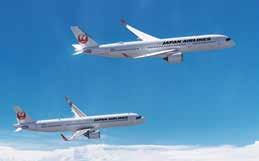
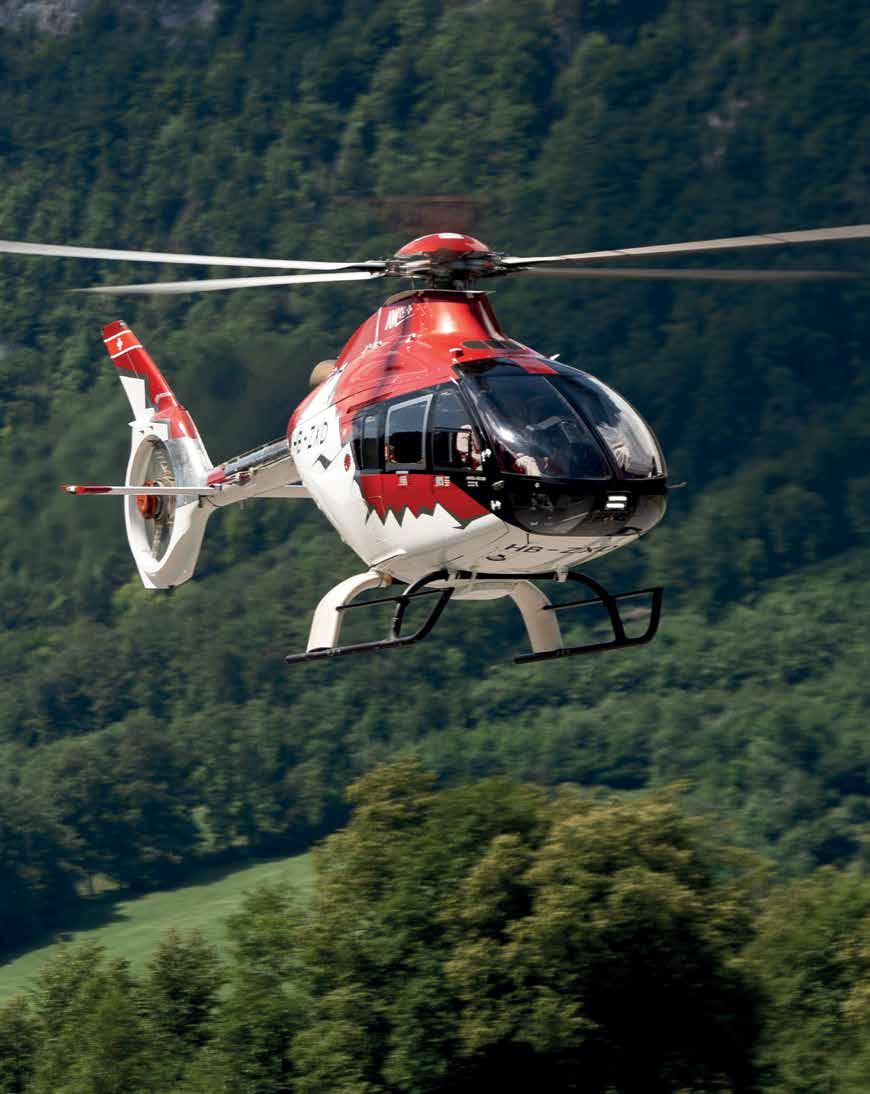
Leonardo offers the largest range of rotorcraft capabilities to operators worldwide. The AW09 is a next-generation, high performance, single-engine helicopter offering the built-in versatility to tackle multiple missions. The AW09 is capable of carrying up to eight passengers, and features state-of-the-art technology and safety, allowing operators to go further and do more.
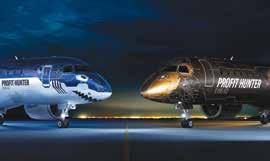


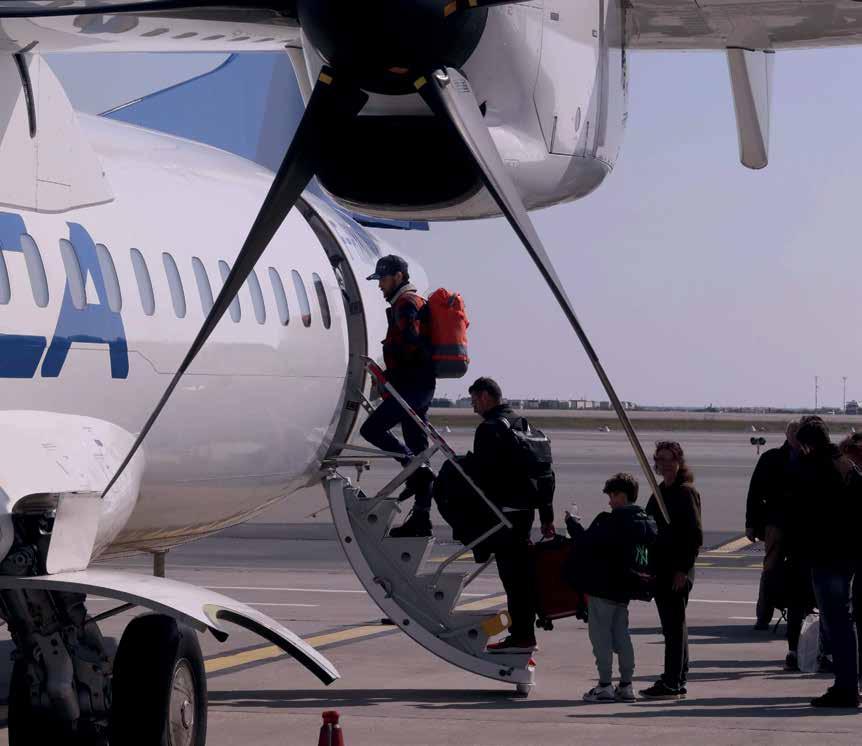




In May this year (2024) Leonardo unveiled a full-scale cabin mock-up of the next generation AW09 single engine helicopter featuring an exclusive VIP-Corporate transport cabin layout and paint-scheme as one of the newly-developed options. By doing so, the market will be offered a unique combination of the superior features of the AW09 in the long-light single engine segment in terms of cabin space/modularity, technology and sustainability features with the distinguished customization, comfort, passenger experience and service characteristics delivered by Leonardo.
The AW09 delivers excellent visibility from both the cockpit and the cabin. It offers the largest cabin and the most generous legroom in the single engine class, allowing the end-user to choose among several elegant yet functional interiors from 4+1 up to 3+3+2 seating layouts depending on flight and view experience preferences. The airframe architecture provides unobstructed side accessibility and unique rear access. The modern five-bladed main rotor and shrouded tail rotor ensure greater comfort and on-ground clearance and safety as well as contributing to a smooth flight.
Operators will also benefit from the advantages of dedicated technical support under a tailored service and maintenance package
and the Leonardo Helicopters Customer Portal. Also, designed as a true digital helicopter and connected from day one, the AW09 will allow data transmission, gathering and analysis for technical support, scheduled maintenance and flight efficiency/safety capabilities with no equals on the single engine market.
The AW09 continues to generate a very positive response from all geographies worldwide as the programme development progresses. The AW09’s outstanding characteristics and multirole capabilities represent a significant evolution compared to existing products in this category. Total Preliminary Sales Contracts for the AW09 is exceeding 100 units globally and keeps growing.
Universal Vulkaan Aviation Pte Limited, appointed as Leonardo’s distributor for the Indian civil helicopter market earlier this year for various Leonardo’s civil helicopter models, signed preliminary sales contracts for five AW09s in May, growing the success of the new type in Asia. This collaboration underscores the partners’ commitment to providing cutting-edge solutions tailored to the Indian market’s evolving needs, considering the country’s booming civil aviation sector and the increasing demand for reliable transportation solutions.
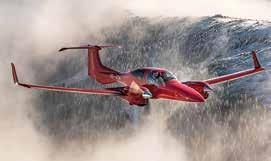
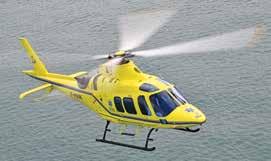



Ideal for Flying Training Organizations
Lowest Operating Costs
Unparalleled Fuel Efficiency
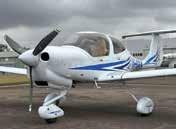

Lowering your costs of Flight is just one of its many advantages.
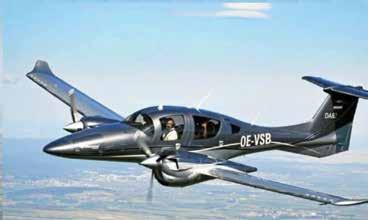
Diamond today has more than 55 aircrafts flying in the Indian Sky with various FT0s, private owners, And that’s because Diamond has efficiency, high reliability, safety, modern design, luxury, single piston engine aircraft, and twin engine aircraft, with larger interior space and performance, durable fully composite airframe, modern high end avionics system and Austro engines with unique options (thrust you can trust.)



To evaluate how effective Diamond aircraft can be addressing your training or other aviation needs, please contact us.
FIFTH ISSUE

Welcome to the 23-2024 edition of SP’s Civil Aviation Yearbook!
The aviation sector is entering a transformative era, with Asia-Pacific market emerging as the central pillar of global air travel. Buoyed by expanding economies, rising middle-class populations, and extensive investments in airport infrastructure, the region is not only recovering from the pandemic-induced downturn but is also charting a course toward unprecedented growth. As air connectivity reestablishes itself both within and beyond borders, Asia-Pacific is set to redefine the contours of global aviation.
This analysis explores recent trends, evolving market dynamics, short- and long-term forecasts, and the major opportunities and obstacles that will shape the region's aviation landscape over the coming decades.
By early 2024, the Asia-Pacific aviation market had firmly entered recovery mode, particularly in domestic air travel segments. According to data from the International Air Transport Association (IATA), domestic passenger traffic in countries such as China and India has already surpassed pre-pandemic levels. This rebound is largely driven
by strong consumer demand, targeted government stimulus packages, and a shift in travel preferences toward short-haul and regional destinations.
However, international air travel continues to lag behind. While restrictions have eased considerably since 2023, lingering visa complexities, uneven reopening policies, and regional geopolitical tensions have kept international traffic below 2019 benchmarks. Notably, long-haul routes to and from China and North America remain under pressure, as regulatory uncertainties and bilateral flight caps constrain capacity growth.
The disparity between domestic and international recovery reflects the nuanced and uneven nature of the region's aviation revival.
The Asia-Pacific aviation ecosystem is being reshaped by a series of structural and economic factors:
Economic volatility and geopolitical concerns have redirected a significant portion of travel demand inward. In markets like China, Japan, and India, robust domestic tourism campaigns and regional air connectivity improvements have generated sustained momentum. China’s domestic air market has become the largest in the world

Set of kind words from Dr S. Radhakrishnan, Second President of India, addressed to our Founder Editorin- Chief, in March 1966 in the context of our first Yearbook - the ‘Military Yearbook’ launched in 1965, and now known as SP’s Military Yearbook. This very longestablished background of the Yearbook has been the foundation of SP’s Civil Aviation Yearbook.
Following the path of the first Yearbook, SP Guide Publications had introduced SP’s Civil Aviation Yearbook in the year 2018 to fill the vacuum of such a detailed reference document on civil aviation industry covering not just India but the countries across Asia. SP’s Civil Aviation Yearbook strives to remain the leader in Asia after having become the first mover in the space of civil aviation reference document.

by passenger volume, according to the Civil Aviation Administration of China (CAAC).
Reduced air traffic between traditional aviation corridors, particularly between China and the United States, has prompted carriers to diversify their route networks. Southeast Asia, South Asia, and Central Asia are emerging as alternative hubs for transit and regional connections. Governments are also incentivizing new air service agreements to promote regional integration.
The rise of budget airlines has fundamentally changed air travel in the region. Carriers such as AirAsia, IndiGo, and Scoot have made flying more affordable and accessible, particularly for first-time flyers and middle-income travellers. The LCC model has become a key growth driver, particularly in underserved secondary cities and emerging markets.
Air cargo emerged as the star performer in 2024, with airlines transporting record volumes and posting strong profits. Demand surged 11.3 per cent year-on-year, fuelled by booming e-commerce and disruptions in ocean freight. Airspace constraints on key Asia routes further tightened capacity, helping to sustain yields at elevated levels. While average yields have eased from their 2021–2022 highs, they remained 39 per cent above 2019 levels.
Looking ahead, IATA projects more measured growth of 5.8 per cent in 2025, in line with long-term trends. “The economic outlook remains positive for air cargo, with falling oil prices and expanding trade,” IATA noted. “Still, the industry must remain agile as geopolitical developments continue to reshape the global landscape.” The recent tariff truce between the US and China has brought temporary relief to the air cargo industry, prompting a surge in shipments as exporters rush to capitalise on the 90-day window. However, the end of the de minimis exemption on low-value goods continues to weigh on e-commerce air freight, slashing capacity
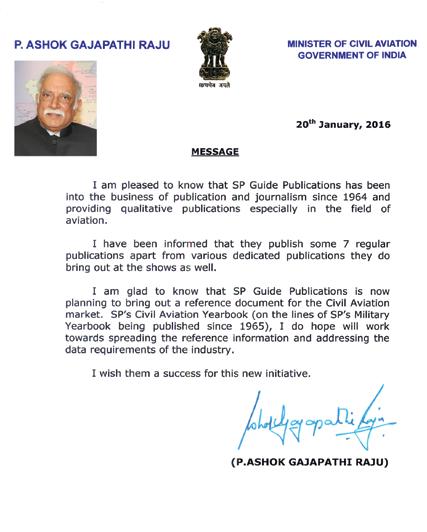
on key China–US routes by nearly 30 per cent. While the pause in hostilities offers short-term gains, long-term uncertainty remains, pushing carriers to diversify routes and explore new markets.
For the first time in aviation history, total industry revenues are projected to exceed the trillion-dollar threshold, reaching $1.007 trillion in 2025—a 4.4 per cent increase from the previous year. Expenses are also expected to rise by 4.0 per cent, totalling $940 billion, reflecting the ongoing challenges posed by escalating operational costs.
The Asia-Pacific region is poised to lead global passenger traffic growth in the near term. IATA projects a year-on-year increase of 7.9 per cent in passenger numbers through 2025 — the fastest growth rate globally. This trajectory is supported by several factors:
Recovering consumer confidence
The thought of having a Civil Aviation Yearbook actually came from then Union Minister of Civil Aviation, P. Ashok Gajapathi Raju who encouraged us to publish a yearbook on Civil Aviation on the lines of our already well-established and reputed SP’s Military Yearbook.
Inspired by the Civil Aviation Minister’s motivation, SP Guide Publications put together SP’s Civil Aviation Yearbook (SP’s CAYB), the only such publication of its nature, the inaugural edition of which was released by the Civil Aviation Minister himself, in 2018.
Competitive airfare pricing by low-cost carriers
Proactive tourism promotion by regional governments (e.g., India’s UDAN scheme, Japan’s "Go To Travel" campaign)
However, risks such as volatile fuel prices, inflationary pressure, and regional security issues could temper the pace of recovery. The market will require agile responses from airlines, airport operators, and regulators to navigate these complexities.
Long-term growth projections remain highly optimistic. According to Airbus and Boeing market outlooks, passenger traffic in AsiaPacific is expected to more than double over the next two decades. The region will account for over 40 per cent of new aircraft deliveries globally, with fleet size projected to exceed 20,000 aircraft by 2043.
The long-term Compound Annual Growth Rate (CAGR) for passenger traffic in Asia-Pacific is estimated at 5.1 per cent, significantly outpacing the mature markets of North America (2.2 per cent) and Europe (1.8 per cent).
Sustainability remains a core priority for the aviation industry, which has committed to achieving net-zero carbon emissions by 2050. Encouragingly, travellers demonstrated high levels of confidence in the sector’s environmental ambitions, with 81 per cent of respondents agreeing that the industry is showing a strong commitment to working collectively toward this goal. Furthermore, 77 per cent believed that aviation leaders are taking the climate challenge seriously.
China continues to anchor the region’s aviation growth. Despite a slower return of international flights, the domestic market has rebounded strongly. The nation is investing heavily in airport infrastructure, with plans to operate over 400 airports by 2035. The CAAC forecasts annual growth in the aviation sector at 5.4 per cent, with major expansions underway in cities like Chengdu, Guangzhou, and Beijing.
India is expected to become the world’s third-largest aviation market by 2027. Domestic travel is surging, propelled by a young population, rising disposable incomes, and major government initiatives such as the Regional Connectivity Scheme (UDAN). The Airports Authority of India (AAI) is investing over `90,000 crore (approximately $11 billion) in airport modernisation and greenfield development projects.
Countries like Indonesia, Vietnam, and the Philippines are experiencing rapid growth in both leisure and business travel segments. Vietnam, in particular, has seen double-digit passenger growth, with Hanoi and Ho Chi Minh City among the busiest emerging airports in the region.
Australia remains a mature but vital player in the region’s aviation ecosystem, underpinned by stable tourism flows and trade ties with Asia. Investments in sustainability, such as carbon-neutral airports and SAF (Sustainable Aviation Fuel) trials, are positioning the country as a leader in green aviation policy.
Technology will be instrumental in managing the region’s aviation expansion. AI-based flight planning, real-time traffic management, and biometric security solutions are already being trialled across major airports. For example, Singapore Changi and Tokyo Haneda are early adopters of smart airport systems designed to reduce wait times and improve passenger flow.
Digitalisation and sustainability are now core pillars of regional aviation policy, as governments and airlines aim to enhance operational efficiency while reducing environmental footprints.
The Asia-Pacific air travel market has demonstrated remarkable resilience and adaptability. As the region solidifies its position as the engine of global aviation growth, collaboration among stakeholders—governments, airlines, airport authorities, and technology providers—will be key to overcoming persistent challenges.
By embracing innovation, fostering regional connectivity, and investing strategically in infrastructure and sustainability, AsiaPacific is well-positioned not only to recover but to lead the aviation industry into a new era of inclusive and dynamic growth.
I hope you enjoy reading the Yearbook! We look forward to your feedback as well
Several distinguished authors and industry experts have contributed to make this edition of SP’s Civil Aviation Yearbook an indispensable reference document that attempts to surpass international standard and quality. We at SP Guide Publications convey our sincere thanks to all of them for their contributions.
As usual, our research team comprising of Bharti Sharma, Rimpy Nischal, Survi Massey and the design team that includes Vimlesh Yadav, Sonu Bisht, did a splendid job under the guidance and supervision of Rohit Goel. It is their dedication and the hard work that has enabled an enormously updated edition. An edition that is not only comprehensive in its data and analysis, but also presented in a very easy-to-understand format.
Clarifications:
Data has been collated and analysed from various sources in each listed country including their official websites of Ministry of Civil Aviation, Directorate of Civil Aviation, Airports Authority and various airlines. Some of the other sources used are various business aviation association websites, IATA, ACI, Wikipedia and OEM websites. Despite this, variations are possible.
Suggestions for improvement will be appreciated and carried out to the extent possible.

Jayant Baranwal Editor-in-Chief
Under the dynamic leadership of Managing Director Vivek Saxena, Kasstech Aerospace has emerged as a leading force in India’s aviation sector. Established in 2019, the company is committed to delivering cuttingedge solutions, specialized maintenance services, and robust product support. With a vision to advance India’s aerospace capabilities, Kasstech Aerospace focuses on bespoke integrations and maintenance, repair, and overhaul (MRO) services for Diamond Aircraft, as well as Austro and Hirth engines.
Kasstech Aerospace has achieved significant milestones through innovation and service excellence:
2019 – Founded by Vivek Saxena to address the evolving needs of India’s aviation sector.
2022 – Recognized as the “MSME of the Year” in Aerospace and Defence.
2022 – Showcased innovations at the Automation India Expo and the 7th International Police Expo.
2023 – Expanded MRO services to support the growing fleet of Diamond Aircraft in India.
2024 – Launched localization and indigenous manufacturing initiatives.
Diamond Aircraft is globally renowned for designing state-of-the-art twin-engine aircraft that prioritize safety, efficiency, and performance. The DA42VI and DA62 are premier choices for flight training organizations, private pilots, and corporate aviation due to their advanced technology and superior aerodynamics.
With the ability to maintain level flight after an engine failure, the DA42-VI is widely adopted by flight training academies worldwide for multi-engine certification.
DA50 RG: NEXT-GEN SINGLE-ENGINE ELEGANCE
The Diamond DA50 RG is a premium five-seat aircraft that merges performance with sophistication. It delivers efficient cruise speeds of up to 181 knots and a range of 820 NM. Its all-carbon composite airframe, retractable landing gear, and Garmin G1000 NXi avionics ensure a sleek, safe, and modern flying experience. With a spacious cabin, luxurious interiors, and advanced safety features, the DA50 RG is ideal for private owners and air charter missions in India’s evolving aviation landscape.

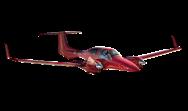
(Top) Vivek Saxena, Managing Director, Kasstech Aerospace; (Above) DA42-VI.
A preferred aircraft for multi-engine training, the DA42-VI combines efficiency, advanced avionics, and exceptional safety features.
Fuel-Efficient Austro AE300 Engines – Jet-A1 fuel-powered turbocharged engines deliver cost-effective operations.
Garmin G1000 NXi Avionics Suite – Provides superior navigation, flight management, and situational awareness.
Lightweight Composite Airframe – Enhances durability, reduces maintenance costs, and improves crash resistance.
Exceptional Safety Measures – Redundant systems, advanced autopilot, and stable handling optimize training.
DA62:
Dubbed the “SUV of the skies,” the DA62 is a highperformance aircraft that blends efficiency, luxury, and extended range, making it a preferred choice for corporate travelers and private owners.
Spacious Cabin – Seats up to seven passengers with premium interiors and panoramic views.
Austro AE330 Engines – Enhances power output while maintaining fuel efficiency and environmental sustainability.
Advanced Avionics – Equipped with Garmin G1000 NXi for intuitive flight management.
Extended Range & Economy – Capable of flying over 1,000 nautical miles with optimized fuel consumption.
Industry-Leading Safety – Composite construction, built-in redundancies, and sophisticated flight controls.
The DA62 seamlessly integrates the performance of a high-powered aircraft with the convenience of a premium business jet, making it a top-tier solution for modern aviation needs.
With over 70 Diamond Aircraft operating across India’s flight training academies and private aviation sector, Kasstech Aerospace plays a crucial role in ensuring their continued efficiency and reliability. The company offers comprehensive maintenance and support services under CAR 145 certification, reinforcing India’s aviation infrastructure.
By driving technological advancements and providing worldclass aviation solutions, Kasstech Aerospace continues to shape the future of Indian aviation, setting new benchmarks in innovation, safety, and operational excellence.


In 2024, global passenger traffic rebounded to pre-pandemic levels, but restricted capacity, supply chain disruptions, and rising non-fuel costs challenged fleet modernisation, while airlines achieved high profits and MRO providers and lessors thrived amid increased demand
BY AYUSHEE CHAUDHARY
At the end of 2024, the commercial aviation sector stood as a testament to resilience and adaptability, marked by a year of recovery, innovation, and transformative trends. From record-breaking passenger traffic to advancements in sustainable aviation fuel (SAF) and continued geopolitical challenges, here are some key highlights from the year.
2024 marked a milestone as global passenger traffic returned to pre-pandemic levels, driven by strong travel demand. However, restricted capacity led to higher airfares, with airlines benefiting from improved load factors and reduced fuel prices, although rising non-fuel costs offset gains. Supply chain disruptions were a significant hurdle, with delivery delays and increased maintenance needs limiting airlines’ ability to modernise fleets and improve efficiency. These challenges raised fleet ages, inflated maintenance costs, and boosted demand for leasing services. Meanwhile, MRO providers and aircraft lessors reaped record profits as industry growth remained constrained. Despite the obstacles, operating profits for airlines stayed historically high, supported by the favorable market dynamics of 2024.
However, among the highlights, many accidents also occurred during 2024, turning emphasis on safety. A total of 318 people died in plane fatalities this year, according to data from the Aviation Safety Network. This marks the deadliest year in aviation since 2018, when 557 people died on commercial flights.
PASSENGER TRAFFIC REACHES NEW HIGHS
Passenger demand continued to soar in 2024, surpassing pre-pandemic levels across all regions. According to IATA, global passenger traffic increased by 6.3 per cent year-on-year, driven by robust leisure travel and growing business demand as economies stabilised. The Asia-Pacific region led the recovery, with China’s reopened borders fueling a surge in international travel. North America and Europe also posted strong growth, reflecting heightened transatlantic travel.
SUSTAINABLE AVIATION GAINS
TO READ THE COMPLETE ARTICLE GET YOUR COPY NOW!
Sustainability remained a dominant theme, with airlines and governments accelerating their push towards net-zero emissions by 2050. SAF
2024 marked a milestone as global passenger traffic returned to pre-pandemic levels, driven by strong travel demand, despite restricted capacity leading to higher airfares
Global Air Passenger Demand Reaches Record High in 2024
The International Air Transport Association (IATA) released 2024 full-year passenger market performance showing record high demand.
y Total Full-year Traffic in 2024 (measured in revenue passenger kilometres or RPKs) rose 10.4 per cent compared to 2023. This was 3.8 per cent above pre-pandemic (2019) levels. Total capacity, measured in available seat kilometres (ASK), was up 8.7 per cent in 2024. The overall load factor reached 83.5 per cent, a record for full-year traffic.
y International Full-year Traffic in 2024 increased 13.6 per cent compared to 2023, and capacity rose 12.8 per cent.
y Domestic Full-year Traffic for 2024 rose 5.7 per cent compared to the prior year, while capacity expanded by 2.5 per cent.
y December 2024 was a strong finish to the year with overall demand rising 8.6 per cent year-onyear, and capacity grew by 5.6 per cent. International demand rose by 10.6 per cent and domestic demand by 5.5 per cent. The December load factor reached 84 per cent, a record for the month. “2024 made it absolutely clear that people want to travel. With 10.4 per cent demand growth, travel reached record numbers domestically and internationally. Airlines met that strong demand with record efficiency. On average, 83.5 per cent of all seats on offer were filled—a new record high, partially attributable to the supply chain constraints that limited capacity growth. Aviation growth reverberates across societies and economies at all
levels through jobs, market development, trade, innovation, exploration, and much more,” said Willie Walsh, IATA’s Director General.
“Looking to 2025, there is every indication that demand for travel will continue to grow, albeit at a moderated pace of 8.0 per cent that is more aligned with historical averages. The desire to partake in the freedom that flying makes possible brings some challenges into sharp focus. First, the tragic accident in Washington last night reminds us that safety needs our continuous efforts. Our thoughts are with all those affected. We will never cease our work to make aviation ever safer.
Second is the airlines’ firm commitment to achieve net zero carbon emissions by 2050. While airlines invested record amounts in purchases of Sustainable Aviation Fuel (SAF) in 2024, less than 0.5 per cent of fuel needs were meet with SAF. SAF is in short supply and costs must come down. Governments could fortify their national energy security and unblock this problem by prioritizing renewable fuel production from which SAF is derived. In addition to securing energy supplies and increasing the SAF supply, diverting a fraction of the subsidies given for fossil fuel extraction to support renewable energy capacity would also boost prosperity through economic expansion and job creation,” said Walsh.
Full-year international traffic surpassed the previous 2019 high by 0.5 per cent in 2024, with growth in all regions. Capacity was 0.9 per cent lower than 2019. The load factor improved by 0.5 percentage points, finishing on 83.2 per cent, a record high.
TO READ THE COMPLETE ARTICLE GET YOUR COPY NOW!
2024 made it absolutely clear that people want to travel. Airlines met that strong demand with record efficiency.
2024 has remained a strong year in the global airlines industry despite declining yields and significant cost pressures
COURTESY IATA
The 2024 numbers are also affected by our upward revision of the profitability in 2023, a year that turned out to be exceptionally strong—actually the fourth best in 30 years. Moreover, 2023 was the first year after the pandemic when capacity utilisation and load factors were restored to pre-pandemic levels, bringing the unit cost down with them. The estimated operating margin for 2024 is 6.4 per cent, which is three percentage points above the 20-year median.
Costs have risen across all non-fuel areas. Following the remarkable profit recovery in 2023, airlines faced demands for salary increases, exacerbated by persistent labour shortages. Other costs have been impacted by supply chain issues, in turn limiting capacity expansion.
One such cost area is maintenance costs, which have risen because of engine-related aircraft groundings and an ageing global fleet. As of 2024, the average aircraft age of the global commercial fleet has reached 14.8 years, the highest on record. An older fleet means more expensive maintenance, higher fuel burn, and additional capex for unplanned retrofits of aircraft that were originally planned to retire already. Since replacements are not available, existing aircraft’s lifetime are extended. We also note a sharp increase in aircraft ownership costs, driven by the lagged
impact of earlier interest rate increases and a sharp rebound in leasing costs amid delays in new fleet deliveries.
All in all, we estimate a 2024 operating profit of $61 billion, implying a 6.4 per cent operating (EBIT) margin. This result is a slight improvement on our previous forecast. However, the composition of the profit has altered. We have revised down our expectations for passenger yields because their return to the long-term declining trend started earlier than expected. Yields have also declined to the extent that lower fuel prices have brought about lower ticket prices. Cargo volumes and yields, supported by the Red Sea crisis and the substantial demand boost from e-commerce and semiconductor industries, have been revised up significantly. Overall, we estimate a net result of $31.5 billion, implying a net profit margin of 3.3 per cent.
The final 2023 estimate, benefiting from the inclusion of surprisingly profitable late-reporting airlines (smaller regional airlines and some Gulf carriers) previously not included in our data, lifts that year’s operating margin from 5.7 per cent to 6.8 per cent. Moreover, high jet fuel price volatility throughout 2023 allowed airlines to hedge at more favourable rates than expected. 2023 was favourable for all types of airlines, including small and local airlines, many of which turned profitable for the first time.
TO READ THE COMPLETE ARTICLE GET YOUR COPY NOW!
Global Air Cargo Demand Achieves Record Growth in 2024
The International Air Transport Association (IATA) released data for full year 2024 global air cargo market performance showing:
y Full-year demand for 2024, measured in cargo tonne-kilometres (CTK), increased 11.3 per cent (12.2 per cent for international operations) compared to 2023. Full-year 2024 demand exceeded the record volumes set in 2021.
y Full-year capacity in 2024, measured in available cargo tonne-kilometres (ACTK), increased by 7.4 per cent compared to 2023 (9.6 per cent for international operations).
y Full-year yields averaged 1.6 per cent lower than 2023 but 39 per cent higher than in 2019.
y December 2024 brought the year to a close with continued strong performance. Global demand was 6.1 per cent above December 2023 levels (7.0 per cent for international operations). Global capacity was 3.7 per cent above December 2023 levels (5.2 per cent for international operations). Cargo yields were 6.6 per cent higher than December 2023 (and 53.4 per cent higher than in December 2019).
“Air cargo was the standout performer in 2024 with airlines moving more air cargo than ever before. Importantly, it was a year of profitable growth. Demand, up 11.3 per cent year-on-year, was boosted by particularly strong e-commerce and various ocean shipping restrictions. This combined with airspace restrictions which limited capacity on some key long-haul routes to Asia helped to keep yields at exceptionally high levels. While average yields continued to soften from peaks in
2021-2022 they averaged 39 per cent higher than 2019,” said Willie Walsh, IATA’s Director General. Looking to 2025, IATA estimates growth to moderate to 5.8 per cent, aligned with historical performance. “Economic fundamentals point to another good year for air cargo—with oil prices on a downward trajectory and trade continuing to grow. There is no doubt, however, that the air cargo industry will be challenged to adapt to unfolding geopolitical shifts. The first week of the Trump administration demonstrated its strong interest in using tariffs as a policy tool that could bring a double whammy for air cargo—boosting inflation and deflating trade,” said Walsh.
SEVERAL FACTORS IN THE OPERATING ENVIRONMENT SHOULD BE NOTED:
y Global trade in goods grew by 3.6 per cent annually in 2024.
y In December, both the manufacturing output Purchasing Managers Index or PMI (49.2) and new export orders PMI (48.2) were below the critical threshold represented by the 50 mark, indicating a decline in global manufacturing production and exports.
y US headline inflation, based on the annual Consumer Price Index (CPI), rose by 0.2 percentage points to 2.9 per cent in December. In the same month, the inflation rate in the EU increased by 0.2 percentage points to 2.7 per cent. China’s consumer inflation fell by 0.1 percentage points to 0.1 per cent in December, marking the fourth consecutive year-on-year decline and reinforcing concerns about an economic slowdown.
TO
READ THE COMPLETE ARTICLE GET YOUR COPY NOW!
Air cargo was the standout performer in 2024 with airlines moving more air cargo than ever before
IATA financial outlook for the Global Airline Industry in 2025
COURTESY IATA
The International Air Transport Association (IATA) announced its financial outlook for the global airline industry in 2025, which shows a slight strengthening of profitability amid ongoing cost and supply chain challenges. Highlights include:
y Net profits are expected to be $36.6 billion in 2025 for a 3.6 per cent net profit margin. That is a slight improvement from the expected $31.5 billion net profit in 2024 (3.3 per cent net profit margin). Average net profit per passenger is expected to be $7.0 (below the $7.9 high in 2023 but an improvement from $6.4 in 2024).
y Operating profit in 2025 is expected to be $67.5 billion for a net operating margin of 6.7 per cent (improved from 6.4 per cent expected in 2024).
y The return on invested capital (ROIC) for the global industry is expected to be 6.8 per cent in 2025. While this is an improvement from the 2024 ROIC of 6.6 per cent, the returns for the industry at the global level remain below the weighted average cost of capital. ROIC is the strongest for airlines in Europe, the Middle East, and Latin America, where it did exceed the cost of capital.
y Total industry revenues are expected to be $1.007 trillion. That is an increase of 4.4 per cent from 2024 and will be the first time that industry revenues top the $1 trillion mark. Expenses are expected to grow by 4.0 per cent to $940 billion.
y Passenger numbers are expected to reach 5.2 billion in 2025, a 6.7 per cent rise compared to 2024 and the first time that the number of passengers has exceeded the five billion mark.
y Cargo volumes are expected to reach 72.5 million tonnes, a 5.8 per cent increase from 2024.
“We’re expecting airlines to deliver a global profit of $36.6 billion in 2025. This will be hard-earned as airlines take advantage of lower oil prices while keeping load factors above 83 per cent, tightly controlling costs, investing in decarbonisation, and managing the return to more normal growth levels following the extraordinary pandemic recovery. All these efforts will help to mitigate several drags on profitability which are outside of airlines’ control, namely persistent supply chain challenges, infrastructure deficiencies, onerous regulation, and a rising tax burden,” said Willie Walsh, IATA’s Director General.
“In 2025, industry revenues will exceed $1 trillion for the first time. It’s also important to put that into perspective. A trillion dollars is a lot—almost one per cent of the global economy. That makes airlines a strategically important industry. But remember that airlines carry $940 billion in costs, not to mention interest and taxes. They retain a net profit margin of just 3.6 per cent. Put another way, the buffer between profit and loss, even in the good year that we are expecting of 2025, is just $7 per passenger. With margins that thin, airlines must continue to watch every cost and insist on
TO READ THE COMPLETE ARTICLE GET YOUR COPY NOW!
Looking at 2025, for the first time, traveller numbers will exceed five billion and the number of flights will reach 40 million
Global passenger and freighter fleet to nearly double over the next 20 years
COURTESY BOEING
With air travel fully recovered and even surpassing pre-pandemic demand, Boeing projected a three per cent increase in airplane deliveries over the next 20 years, with carriers requiring nearly 44,000 new commercial airplanes by 2043. Leading into the Farnborough International Airshow, Boeing released its 2024 Commercial Market Outlook (CMO), which also predicts emerging markets and global single-aisle market demand will remain primary growth drivers for the industry.
Air travel demand continues to outpace economic growth in an increasingly connected world. Four years after the pandemic grounded most of the global fleet, air traffic growth has returned to the long-term trend Boeing forecast 20 years ago. Compared to 2023, passenger air traffic will rise an average of 4.7 per cent annually over the next two decades, according to the CMO.
“This is a challenging and inspiring era for aviation. The return to more typical traffic growth shows how resilient our industry is, even as we all work through ongoing supply chain and production constraints amid other global challenges,” said Brad McMullen, Boeing Senior Vice President of Commercial Sales and Marketing.
CMO forecast Highlights Through 2043
y The global commercial fleet is projected to grow 3.2 per cent annually, more slowly than air
traffic as airlines continue to boost productivity by increasing load factors and using airplanes more hours per day.
y The air cargo fleet, with speed and reliability, consistently outperforms other modes of transport and will increase by two-thirds by 2043, to support 4.1 per cent annual air cargo traffic growth.
Air travel Trends
y The average global airline fare is about the same as it was 20 years ago, even as overall consumer prices doubled.
y The number of global routes served by commercial airlines has returned to 2019 levels, even though nearly 20 per cent of them are new, illustrating the adaptability of aviation in a dynamic market.
Key growth Drivers
y South Asia passenger traffic will increase 7.4 per cent, followed by Southeast Asia (7.2 per cent) and Africa (6.4 per cent), as emerging markets return to historical growth trends through the forecast period.
y Eurasia is projected to lead all markets with the most airplane deliveries (22 per cent of total) with North America (20 per cent) and China (20 per cent) close behind.
TO READ THE COMPLETE ARTICLE GET YOUR COPY NOW!
y Single-aisle airplanes will make up 71 per cent of the 2043 fleet after 33,380 new deliveries, serving short- to medium-haul routes with versatility.
Boeing projects a 3 per cent increase in airplane deliveries over the next 20 years, with carriers requiring nearly 44,000 new commercial airplanes by 2043
Airbus’ latest 20 year Global Market Forecast (GMF) for the 2024-2043 period offers a forward-looking view of air traffic and fleet evolutions
COURTESY AIRBUS
Over the last four years, air transportation has again proved its resilience through the deepest and longest crisis in its history. Now, traffic and airline operations are broadly back to pre-COVID levels or higher with a few exceptions. Consequently, 2023 is used as the baseline year for traffic and fleet for the first time since 2019.
This experience has highlighted once more the vital role played by aviation in connecting
people and communities and as a catalyst for trade between them.
GMF 2024-2043 connects short and long term trends, reflecting dynamic future traffic evolution particularly in regions showing significant pent-up demand, notably Asia Pacific.
In the short term Airbus still see the conditions for strong growth. In the longer term, our forecast connects drivers for air transport demand
Embraer has published Market Outlook 2024, its 20-year forecast for commercial aircraft deliveries in the sub-150-seat category. Market Outlook 2024 estimates 10,500 orders for new jets and turboprops through 2043. It also presents analyses of global influences and trends in six world regions that impact the demand for new aircraft.
COURTESY EMBRAER
The relevance of the small narrowbody category is increasing. Larger aircraft are not always economically or operationally optimal for medium and lower-density markets, particularly when multiple daily frequencies are essential for those cities to stay well-connected. Fleets with these aircraft benefit when complemented by smaller narrowbodies in the sub-150seat segment. Small narrowbodies go where bigger jets cannot, do so more frequently, and usually more profitably. As the average aircraft size in key world regions increases, a reflection of the strong orderbook for 200-seat narrowbodies, it becomes clear that a mixed fleet of small and large narrowbodies is the best way to serve the diverse characteristics of an airline network.
Consolidation has peaked and is expected to slow. Most hubs are now optimised and airlines are focusing on expanding their networks. There are risks associated with up-gauging to larger aircraft.
y Demand Uncertainty: According to the FAA’s
2024-2044 Aerospace Forecast, in the mediumterm, airlines will need to determine which shifts in post-pandemic demand will be permanent and which will fade.
y Demand Behaviour: Changes to both day-ofweek and time-of-day travel patterns emerged after the pandemic due to fewer business trips and more hybrid business/ leisure trips. The previous patterns may not return although many carriers are investing in premium cabins with the expectation that customers will continue to be willing to pay for an upgraded experience. That trend has been evident over the past two years, but it is not certain to continue.
y Opportunities are in the Smaller Markets: Short-haul connectivity is key to long haul success. Smaller markets are driven by operational realities such as infrastructure limitations including runway length, or commercial optimisation for variations in demand and schedule frequency. Smaller jets offer the ability to fly more daily frequencies at different times throughout the day to satisfy customer preferences.
TO READ THE COMPLETE ARTICLE GET YOUR COPY NOW!
Given the strong demand for 200-seat narrowbodies, it’s evident that a balanced fleet of both small and large narrowbodies offers the most effective way to meet the varied demands of an airline’s network
Honeywell’s 2024 Global Business Aviation Outlook
After an amazing six-year runup, business aviation activity has reached a recent high level and is settling in for a prolonged period of steady growth. Aircraft manufacturers expect to deliver 830 new business jets valued at $27 billion in 2025, capping an impressive stretch that began in 2019 during which aircraft deliveries were up 16 per cent and spending on new aircraft climbed 32 per cent.
With 2025’s near-record numbers as a starting point, our analysis of macroeconomic trends and operator feedback indicates business aviation deliveries will continue to grow steadily for at least the next decade. Honeywell thinks business jet deliveries and expenditures will grow at compounded rates of at least two per cent and three per cent respectively between 2024 and 2033.
Aircraft owners and operators will invest an estimated $280 billion in new business jets between 2024 and 2033. This 10-year projection is up slightly from the $278 billion forecast in last year’s Outlook. Aircraft deliveries will total 8,500 during the period, starting with 830 new business jets in 2025, which is up from 750 in 2024.
KEY FINDINGS:
Operators show a decided preference for business jets that can comfortably carry more passengers on longer flights. Larger jets will account for twothirds of aircraft spending in the 10-year period.
Aircraft performance and total cost of ownership – not just acquisition cost – are the main factors buyers consider when choosing a new aircraft.
Ninety-three per cent of operators plan to fly as many or more hours in 2025 as they did in 2024. Business aircraft access continues to expand as new users come on board through fractional ownership, leasing and jet card programmes, which also help increase demand for new aircraft.
Aircraft manufacturers are answering the call with new and refreshed aircraft models equipped with more efficient engines, new flight decks, advanced satellite communications technologies and more.
Record-breaking increases in aircraft deliveries and spending, fuelled by demand for larger and more expensive jets, positions business aviation to grow steadily from a new, much higher baseline. Aircraft owners and operators plan to spend $280 billion on 8,500 new business jets in the coming decade.
Near term, aircraft operators are looking to add aircraft to their fleets and replace their existing aircraft at about the same rate as respondents to last year’s Outlook. Additions and replacements between 2025 and 2029 will be equivalent to about 18 per cent of operators’ current fleets.
Honeywell expects to see a two per cent compounded annual growth rate for aircraft deliveries during the 2024-2033 time period, while expenditures will expand slightly faster at a three per cent rate. These more typical growth numbers come on the heels of a particularly robust stretch of time (2019-2025) during which deliveries rose 16 per cent and spending grew 32 per cent.
TO READ THE COMPLETE ARTICLE GET YOUR COPY NOW!
Aircraft owners and operators will invest an estimated $280 billion in new business jets between 2024 and 2033
The annual analysis and forecast for the pre-owned Business Aviation market
This edition marks an evolution in industry forecasting. Jetcraft has leveraged comprehensive transaction data alongside metrics on shifting customer demographics and buying behaviours to present an accurate and compelling picture of the next five years for the business aviation community.
Transaction volume and values are up, promising steady and sustainable growth over the coming five years.
STRONGER. STEADIER. MORE SUSTAINABLE.
2023–24 saw a much-needed market correction period, with transaction volumes returning to prepandemic levels and values levelling out above the 2019 peak.
Throughout 2025, the market will maintain these upward trajectories with steady and sustainable growth. Gone are the frenzied days of low inventory and short days-on-market trends, as new confidence and stability leave the early 2020s firmly in the rear-view mirror.
Increased volume in the Large jet segment is helping drive a five-year forecast of 11,202 preowned aircraft sales, totalling $73.9 billion in transactions.
This segment is expected to expand further as new models enter the market, boosting pre-owned sales. Meanwhile, a rising wave of younger buyers continues to fuel long-term industry-wide growth.
Political factors drive confidence in the US, young HNWIs become a force in EMEA, and Asia-Pacific creates demand for newer aircraft.
A shift in generational wealth and an increase in ‘new tech’ billionaires is contributing to continued growth in younger buyers.
Over the past decade, the market share of buyers under 45 has nearly doubled. This mirrors rapid growth in the tech, AI and finance sectors, where younger HNWIs are generating new wealth and leveraging business aviation to support their business and lifestyle needs.
This trend is further accelerating globally as wealth transitions to the next generation, with an increasing number of HNWIs inheriting businesses and investments at a younger age. Jetcraft is seeing this market trend in real-time, and with it, increasing diversity, with 42 per cent of Jetcraft buyers under 45 coming from the entertainment industry and 29 per cent being women.
Corporate buyers currently represent around 60 per cent of transactions globally, with the majority coming from the finance sector. Demand for younger and larger jets remains strong in Asia and the Middle East, where the Bombardier Global 7500 has been the most frequently traded model among our buyers in 2024. This regional shift is further amplified by a cultural preference for newer aircraft, driving sustained growth in the segment.
TO READ THE COMPLETE ARTICLE GET YOUR COPY NOW!
Increased volume in the Large jet segment is helping drive a five-year forecast of 11,202 preowned aircraft sales, totalling $73.9 billion in transactions


“The
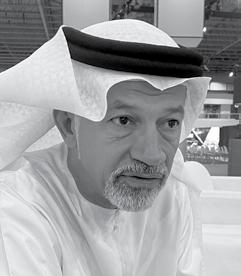
In an exclusive chat with Jayant Baranwal, Editorin-Chief, SP Guide Publications at the recently concluded MEBAA 2024, Ali Ahmed Alnaqbi, Chairman of the IBAC Governing Board, and Founding Chairman, Middle East and North Africa Business Aviation Association (MEBAA) shared his insights and vision on Business Aviation’s Role, Challenges and a Sustainable Future
Jayant Baranwal (Baranwal): What are the key roles business aviation play in the interest of world countries and society?
Ali Ahmed Alnaqbi (Alnaqbi): Well, business aviation, you know, plays so many roles and the most important is, contribute in the growth of economies. The people who actually make the investment are our clients, so we carry them safely from one place to another place. Our role as business aviation is very important, taking the investors safely from one place to another place. Sometimes, we also take them to a new area where airline cannot reach and that’s the leverage of having a business aircraft. The business aircraft can land not only in a big airport, it can land anywhere, with special permission. Airlines cannot go except to a hub, which we have seen. And then we are, as you know, part of economy development. We are part of the process of creation of jobs. We create jobs for thousands and millions of people around the world.
Business aviation is vital, when it comes to support, you know, like charities, and supporting
those companies who needed help. We transfer sick people, who cannot be mingled with others on an airline, from one area to another area. We, in certain area, transfer organs of human to another hospital. It doesn’t go by the airline for various reasons. So, we play so many roles, in addition to our existing set of roles. And one of the main things is, we help in making company profitable. So basically, we work with the companies. And most of the bigger companies in the world, are actually using private and business aircraft. The reasonthey save time, and they don’t have to wait so long with the airlines. They also are able to avoid long queues in the airport. And, you know, they want to do business and come back. So, it is a factor of business tool for profitability and creativity and making the company a success.
Baranwal: Can you list down some of the major challenges the industry is still facing?
TO READ THE COMPLETE ARTICLE GET YOUR COPY NOW!
Alnaqbi: Again, a lot of issues that the business aviation facing mainly come from the
“When we started MEBAA in 2006, there were a few companies in the whole region doing business aviation. Now in the region we have more than 370 companies.”
“Middle-East
pad, and our aircraft are well-suited

The MEBAA show, held in Dubai every second year, witnesses a very regular participation of Gulfstream Aerospace. The 2024 edition held in December last year also witnessed a great and active participation of Gulfstream. Jayant Baranwal, Editor-in-Chief, SP Guide Publications, had an exclusive conversation at this occasion, with Michael Swift, Group Vice President – Sales, EMEA & APAC, Gulfstream Aerospace
Jayant Baranwal (Baranwal): How was Gulfstream’s current fleet conceptualised? Can you elaborate a little bit on the journey till now?
Michael Swift (Swift): Gulfstream conceptualised our next generation aircraft family with a holistic strategy for a fleet for every mission which includes the G400, G500, G600, G700 and G800. This began with the launch of the G500 in 2013, and you can see that fleet strategy come into play even more now with the recent certification of the G700, the G800 around the corner and the G400 to follow.
Baranwal: And what is the standing of, if you can just give me a little brief overview of
Gulfstream family, in the world market today. How do you perceive that?
Swift: It’s a good question. The Gulfstream fleet is well accepted around the world. For my part, I cover all the sales teams outside of the Americas. So, I have Europe, the Middle East, Africa and Asia, and we see robust demand for all our aircraft in each market. It really comes down to the end client, where they’re flying, where they need to go, and we believe we have a Gulfstream for every mission.
Baranwal: What sets Gulfstream apart?
TO READ THE COMPLETE ARTICLE GET YOUR COPY NOW!
Swift: We’re a leader in innovation; we’re a leader in sustainability; and we deliver the finest aviation
“The Gulfstream fleet is well accepted around the world. We believe we have a Gulfstream for every mission.”

Dassault Falcon Business Jets are redefining luxury and safety in Business Aviation. Carlos Brana, Executive Vice President Civil Aircraft, Dassault Aviation shares insights into the company’s vision and cutting-edge technology in an exclusive conversation with Jayant Baranwal, Editor-in-Chief of SP Guide Publications, during 2024 edition of MEBAA held in Dubai.
Jayant Baranwal (Baranwal): First of all, what are the very key features of Falcon family jets which make them different from any other jets in the world?
Carlos Brana (Brana): Well, let’s say that when the Falcon started, of course, one of the key features was safety. At the time, in the 1960s, 1963 actually, when we launched the first Falcon, a lot of people didn’t know very much what aviation was really, although they had the opportunity to fly, but, you know, there were a lot of accidents and so on. And so, our tradition was to make sure that the airplane was safe. With time, we have made progress to be more and more safe, and so on. And right now, we have the flight control system, which is the core of the safety of the airplanes. So, now we have the digital flight control system. This is one of the big features of the Falcon. And thanks to that, they are deemed extremely safe. Actually, to be clear with you, we never lost the Falcon 2000, never lost the Falcon 900 and have
never lost the 7X. So, all these airplanes, maybe we were lucky, but at least no incidents or no accidents, which led to the destruction of the airplane. So, it is to say, this is the thing we have been doing for years. The second point is about efficiency. What we have been doing for many, many years is develop efficient airplanes. Efficient airplanes is that you adapt, let’s say, the size of the engines to the size of the airplane. So, you design a very aerodynamic airplane with nice wings and so on, but also you adapt the thrust of the engine to the size of the airplane. If you have too much thrust, it’s nice, but on the other hand, your efficiency is not that good. For example, if you take a threeengine airplane, you have three small engines, and this is a very efficient airplane when it’s cruising. If you take two engines, a two-engine airplane will have bigger engines, because once you start to take off, if there is a fail of one engine, you still need to be able to take off with one engine. So, of course, you need to have the thrust for that. With
TO READ THE COMPLETE ARTICLE GET YOUR COPY NOW!
“Business aviation is not only for the super-rich. It’s a tool—a flying office that saves time and creates opportunities.”

André Zimmermann, Vice President Business Aviation, Pilatus Aircraft Ltd talks to Jayant Baranwal, Editor-in-Chief, SP Guide Publications on what keeps Pilatus PC-12 NGX and PC-24 amongst the most popular business aircraft around the world
Jayant Baranwal (Baranwal): How do you define “Crafted in Switzerland”?
André Zimmermann (Zimmermann): Pilatus enjoys an excellent reputation for its premium workmanship. This is reflected in numerous votes of confidence from within the aerospace sector. Praise is not the driving force behind our efforts. Our goal is rather to ensure the survival of a national heritage which the world knows by the name “Swiss Made”, cutting-edge technology paired with the precision craftsmanship of the highest order. “Crafted in Switzerland”, as we say.
Baranwal: Your aircraft originate from one of the coolest countries in the world. Are they tailored
and accustomed for the extreme weather conditions which remain integral feature for many of the countries around the world?
Zimmermann: Pilatus started writing history as a producer of new aircraft types with the SB-2 Pelican built in 1940. It was designed especially for use in mountainous regions such as the Swiss Alps. The worldwide breakthrough came in 1959 with the Pilatus Porter PC-6. This multipurpose aircraft enjoyed huge popularity for its extraordinarily rugged frame and superb STOL characteristics – the ability to fly in and out of short runways. The PC-6 was built for customers around the world for full 60 years. Few aircraft anywhere can match such a long production run.
The Pilatus Porter PC-6 enjoyed huge popularity and was built for customers around the world for a full 60 years TO READ THE COMPLETE ARTICLE GET YOUR COPY NOW!

“Safety and quality always have been our utmost priorities. Over time we have positioned ourselves as the leading brand in the attractive large cabin market, along with leading products and technology capability,” says Lindsey Stuss Gillen, Vice President, Sales & Marketing – Business Aviation, Rolls-Royce in an interview with Jayant Baranwal, Editor-in-Chief, SP Guide Publications
Jayant Baranwal (Baranwal): Please can you take us through your journey of six decades of your association with the Business Aviation industry?
Lindsey Stuss Gillen (Gillen): From the beginning in 1958, which was marked by the first flight of the Dart-powered Gulfstream I, through to the imminent entry into service of the Pearl-powered Gulfstream G800, Rolls-Royce has followed a pioneering approach to offer its customers extraordinary engine technology and services.
Over the last six decades Rolls-Royce has become the world’s leading engine supplier in business aviation, powering some of the largest, fastest and longest-range business jets available. Today more than 4,000 of these aircraft are in service worldwide, helping companies to improve business efficiency, productivity and enabling economic growth. They offer the flexibility and connectivity required in a globalised world, fly heads of states around the globe, support humanitarian efforts or connect families by making the world a smaller place.
Baranwal: How many business jets have been powered by your engines, till now?
Gillen: Over 4,000 Rolls-Royce powered aircraft are in-service and flying worldwide today, offering the perfect combination of speed, range, size, efficiency and reliability.
Baranwal: Rolls-Royce is synonymous with the Quality. What all it takes to remain consistent with such line of expectation in today’s costcompetitive world?
Gillen: Safety and quality always have been our utmost priorities. Over time we have positioned ourselves as the leading brand in the attractive large cabin market, along with leading products and technology capability.
However, Rolls-Royce continues to create a high performing, competitive, resilient and growing business and we are on track to deliver returns above the industry average in a resilient and growing market. To achieve this, we are also further reducing unit cost.
TO READ THE COMPLETE ARTICLE GET YOUR COPY NOW!
“Over 4,000 Rolls-Royce powered aircraft are in-service and flying worldwide today, offering the perfect combination of speed, range, size, efficiency and reliability”
“Our aircraft are most modern, highly efficient, reliable, cost-effective and future-proof”

In a candid interview, ATR CEO Nathalie Tarnaud Laude talks on wide-ranging subjects including Innovation, Sustainability, and the Future of Regional Connectivity with Jayant Baranwal, Editor-in-Chief, SP Guide Publications
Jayant Baranwal (Baranwal): Since taking over as the CEO in September 2022, how has been your journey so far?
Nathalie Tarnaud Laude (Laude): My journey with ATR has been both incredibly challenging and rewarding. Coming into this role shortly after the COVID crisis, my main focus has been on ramping up production to serve our customers while preparing for the future, focusing on sustainability and innovation. This is precisely what the regional aviation market is asking us: delivering highly fuel-efficient aircraft, which are also versatile, affordable and future-proof.
As you know, an aircraft is among the most complex industrial products, with stringent rules and
regulations designed to ensure the highest levels of safety. Relaunching production and supporting our supply chain to get back to pre-Covid levels has been a true challenge, and last year’s results show a very positive evolution, with 36 aircraft delivered, which is 44 per cent more than in 2022. Our target is to keep ramping up with an ambition to reach 80 aircraft produced per year by the end of the decade to meet the growing needs of regional connectivity worldwide. We also had a record year in 2023 from different perspectives. Our Support and Services activities reached revenues of over $400 million, which shows that our operators rely on us to support their operations. We welcomed 11 new customers
TO READ THE COMPLETE ARTICLE GET YOUR COPY NOW!
“Currently, 85.5 per cent of ATR parts are recyclable or reusable, and we are actively exploring new designs and materials to further enhance this figure”


The rise of artificial intelligence (AI) allowing creation of intelligent systems that can provide advanced assistance solutions, optimise aircraft performance, improve air traffic management and enhance safety in ways that were previously unimaginable, has the potential to transform the world of aviation.
The European Union (EU) has developed a comprehensive strategy for AI at a global level, which is designed to ensure that AI is developed and used in a way that is human-centric, trustworthy and safe. The strategy involves four main actions:
y enabling conditions for AI development and uptake in the EU, including establishing a regulatory framework that promotes innovation while ensuring safety and ethics;
y making the EU the place where excellence thrives from the lab to market, fostering an ecosystem that supports startups and SMEs in AI development;
y ensuring that AI works for people and is a force for good in society, with a focus on promoting diversity, transparency, and accountability;
y building excellence in AI through strategic leadership in high-impact sectors, such as healthcare, mobility, and energy, by fostering collaboration between industry, academia, and public institutions, and ensuring access to data and computing power. Overall, the EU is committed to a human-
centric approach to AI that respects fundamental rights and values, promotes inclusion and diversity, and supports sustainable and responsible innovation.
Multiple domains of the aviation sector will be impacted by this emerging technology. The air transport system is facing new challenges: increase in air traffic volumes, more stringent environmental standards, growing complexity of systems, greater focus on competitiveness, for which AI could provide opportunities. This provides a general overview of the anticipated impact on each aviation domain in terms of use cases.
AI, and more specifically the ML field of AI, is bringing an enormous potential for developing applications that would not have been possible with the development techniques that have been used so far.
On the one hand, the breakthrough of DL has brought about a wide range of applications that could benefit aviation; in particular, computer vision and natural language processing (NLP)
TO READ THE COMPLETE ARTICLE GET YOUR COPY NOW!
The current available technology does not match the anticipated levels of adaptability, rationality and management of uncertainty that aviation products should be meeting to reach autonomy
Next-generation airliners will feature innovative airframe designs, utilising lighter and stronger composite materials and advanced aerodynamic shapes with alternative propulsion systems to enhance fuel efficiency and reduce carbon emissions.
BY ANIL CHOPRA
The aviation industry has made a commitment to achieving “netzero” carbon emissions by 2050. But this ambitious target cannot be achieved using existing aircraft technologies. New airframe designs, alternative propulsion systems and low-carbon energy sources, as well as innovative solutions to existing challenges, will help significantly reduce CO2 emissions in future aircraft.
Human beings continue to emulate the birds to make civil aviation more efficient, eco-friendly, sustainable, with longer range, smoother ride, and greater passenger comfort. This is aimed to be achieved through better aerodynamic design, lighter but stronger composite materials, and more efficient and eco-friendly fuel burning engines with lower carbon emissions.
NASA and MIT in the US have come up with a radical new aeroplane wing design that is not only much lighter than conventional wings, but also has the potential to automatically reconfigure itself to meet the flight conditions of the moment – just like birds do when they’re in mid-flight. Built out of tiny, identical polymer tiles they promise faster, cheaper aircraft production and maintenance.
More options such as supersonic bi-directional flying-wing that will allow lower speed take-off, yet, go supersonic in flight. For subsonic mode, the airplane will be rotated 90° so that the side of the airplane during supersonic flight becomes the front of the airplane. This ‘airliner of the future’ has a radical new wing design. Many more projects are evolving. Each has its advantages and challenges.
Blended flying-wing design is generally evolving as the concept has got well researched with years of military plane operations.
The blended wing body (BWB) concept offers advantages in structural, aerodynamic and operating efficiencies over today’s more conventional fuselage-and-wing designs. These features translate into greater range, fuel economy, reliability and life cycle savings, as well as lower manufacturing costs. They also allow for a wide variety of potential military and commercial applications. The first scaled model of KLM Royal Dutch Airlines’ futuristic Flying-V aircraft designed by Delft University of Technology flew in 2020. Airbus ZEROe blended wing concept was unveiled in 2020. ZEROe programme will have
TO READ THE COMPLETE ARTICLE GET YOUR COPY NOW!
The aviation industry has made a commitment to achieving “netzero” carbon emissions by 2050. This ambitious target cannot be achieved using existing aircraft technologies.
Aircraft powered by batteries or hydrogen will require some changes at Aerodromes
New generation aircraft, capable of operating with hydrogen or batteries, are expected to enter service in the foreseeable future and contribute to ICAO’s Long-term Aspirational Goal (LTAG) of Net Zero CO2 emissions by 2050. These aircraft will coexist with traditional kerosene-powered aircraft in new and existing aerodromes as they are introduced into the market. The aviation industry (aircraft manufacturers, airlines, airports, and air service navigation providers) is closely working with governments to ensure aerodrome compatibility and to facilitate the integration of these aircraft technologies into the aviation ecosystem in a safe, efficient, timely, and harmonised manner.
Looking to the future, one of the most significant changes to aerodromes worldwide will be the aircraft powered by alternative fuel types – mainly hydrogen and electricity. These two new fuels have been identified as important contributors to the decarbonisation efforts underway across the industry, but they also have the potential to generate some new challenges for aerodrome operators that need to be identified and managed appropriately.
To create a common understanding of the aerodrome
operations of aircraft powered by hydrogen or batteries, this section briefly describes the concepts and the general operating model of these concepts.
There are two main pathways to extract the energy from hydrogen and use it to power an aircraft. One is reversing the electrolysis process and recombining hydrogen with oxygen in a fuel cell to generate electricity. The electrical energy generated through this process can then power an electric aircraft. In this case, liquid water is a by-product of the fuel cell chemical reaction.
Hydrogen gas is flammable, just like kerosene, so using it in a purpose-built gas turbine engine is possible. In this way, thermal energy is extracted from the combustion of hydrogen to power a turbine, similar to the way conventional fuels work in existing gas turbine engines.
Challenges exist for using gaseous and liquid hydrogen as aircraft fuel, such as refueling/defueling operations, LH2 module swap procedure, H2 storage in the aircraft, H2 storage and distribution at the aerodrome, and maintenance. Importantly, thermal/pressure management within the hydrogen tank while the aircraft operates at the aerodrome will have to be adequately managed. For example, aircraft designs should consider extended or overnight stays where liquid hydrogen
TO READ THE COMPLETE ARTICLE GET YOUR COPY NOW!
New generation aircraft, capable of operating with hydrogen or batteries, are expected to enter service in the foreseeable future and contribute to ICAO’s Long-term Aspirational Goal (LTAG) of Net Zero CO2 emissions by 2050
Achieving net zero by 2050 requires immediate, collaborative, and transformative action from governments, airlines, manufacturers, and other stakeholders to invest in SAF, cutting-edge technologies, and innovative operational efficiencies
BY JOSEPH NORONHA
The news about global warming leading to climate change gets worse by the day. In October 2024, a new UN report warned that without determined action to decarbonise the economy the world could warm by a huge 3.1C this century, leading to dramatic increases in extreme weather events, including heatwaves and floods. It says that the goals of the Paris Agreement to keep global warming under 2C while making efforts to stay below 1.5C are now in very serious danger. The landmark Paris Agreement of 2015, that sought to address climate change and its negative impacts, was adopted by nearly every nation of the world. Pledges galore followed. Indeed, if every country simply puts their stated plans into action and honours their own net zero pledges, the global temperature rise could still be contained to 1.9C. Yet action on the ground has been unimpressive, to say the least.
Currently, only about 10 per cent of the global population flies and aviation accounts for just 2.5 per cent of global greenhouse gas (GHG) emissions. But when non-CO2 effects are included, aviation’s contribution to global warming increases to approximately four per cent. This figure could triple by 2050, as rising incomes encourage more people
to travel by air. The International Air Transport Association (IATA), at its Annual General Meeting in October 2021, pledged to achieve net zero carbon emissions by 2050. Adding weight to this decision, in October 2022, member states of the International Civil Aviation Organization (ICAO) also agreed to a long-term aspirational goal (LTAG) of net zero emissions from aviation by 2050. Net zero means the amount of GHG removed from the atmosphere is equal to that emitted by the specific human activity, in this case aviation. Is aviation net zero by 2050 an achievable goal? Some analysts declare that it is unlikely, perhaps even impossible. However, while recognising that aviation is one of the most stubbornly difficult industries to decarbonise, IATA asserts that net zero by 2050 is definitely practicable. To bolster its claims it has released five net-zero roadmaps. Researchers at the University of Cambridge broadly agree. They have released their own blueprint which says the sector could reach net zero by 2050 if urgent action is taken in the next five years.
TO READ THE COMPLETE ARTICLE GET YOUR COPY NOW!
IATA’s five roadmaps are a step-by-step listing of the main actions required to be taken not just by
IATA says that success of net zero 2050 will depend mainly on early policy support and the pace at which solutions are implemented
5
Researchers at Argonne National Laboratory have developed a process that converts wastewater into biofuel components, offering a cost-competitive and sustainable alternative for SAF production
BY SUKHCHAIN SINGH
Aircraft have been fuelled by kerosene over the last century and have been emitting high volumes of Greenhouse Gas Emissions (GHG). Now, a new generation of sustainable aviation fuels have been developed which have the potential to halve the aviation industry’s carbon emissions by 2050. Sustainable aviation fuel (SAF) is a certified jet fuel (Jet-A/A1). However, unlike traditional jet fuel that is, from fossil resources, today’s SAF is a blend of conventional fossil fuel and synthetic components that are prepared from a range of renewable “feedstock” (such as used cooking oils, fats, plant oils, municipal, agricultural and forestry waste). SAF can be blended at various levels with limits between 10 per cent and 50 per cent, depending on the feedstock and how the fuel is produced. SAF so blended with conventional Jet A can be used as drop-in fuel for the existing engine & aircraft integration. Worldwide, 12 per cent of all carbon dioxide (CO2) emissions are from the transportation sector of which aviation accounts for 2-3 per cent of all CO2 emissions. ICAO’s Carbon Offsetting and Reduction Scheme for International Aviation (CORSIA) plugs the net CO2 aviation emissions at 2020 levels through 2035. The international aviation
industry has set an aspirational goal to reach net zero carbon by 2050. SAF presents the best nearterm opportunity to meet these goals.
SAF can be produced from a variety of nonpetroleum-based renewable feedstocks like food and waste portion of municipal solid waste, woody biomass, fats/greases/oils, and other feedstocks. There are multiple technology pathways to produce these fuels which are approved by American Society for Testing and Materials (ASTM) and also their blending limits based on these pathways. ASTM D7566 Standard, Specification for Aviation Turbine Fuel Containing Synthesised Hydrocarbons, dictates fuel quality standards for non-petroleum-based jet fuel and outlines approved SAFbased fuels and the per cent allowable in a blend with Jet A. ASTM D1655 Standard, Specification for Aviation Turbine Fuels allows co-processing of biomass feedstocks at a petroleum refinery in blends up to five per cent. Both ASTM standards are continuously updated to allow for developments in technology to produce SAF. The nine approved pathways are:
y Fischer-Tropsch (FT) Synthetic Paraffinic Kerosene (SPK): Woody biomass is converted to syngas using gasification, then a FischerTropsch synthesis reaction converts the syngas
TO READ THE COMPLETE ARTICLE GET YOUR COPY NOW!
The international aviation industry has set an aspirational goal to reach net-zero carbon emissions by 2050, with SAF presenting the best near-term opportunity despite challenges such as high costs and limited feedstock availability
6
Several key technological advancements are enabling the rapid commercialisation of eVTOL aircraft
BY AYUSHEE CHAUDHARY
As cities worldwide grapple with increasing congestion and environmental concerns, the aviation industry is undergoing a revolutionary transformation. Electric Vertical Takeoff and Landing (eVTOL) aircraft are emerging as a game-changer in urban air mobility, offering a sustainable, efficient, and versatile solution for both passenger and cargo transportation. These aircraft, powered by electric propulsion systems, are designed for vertical takeoff and landing, ensuring quiet, emission-free operations that can seamlessly integrate into urban environments. With the ability to hover, maneuver in confined spaces, and the potential for autonomous flight, eVTOLs are poised to redefine the way we travel within cities, serving as air taxis, emergency response units, and logistics platforms while significantly reducing noise pollution and carbon emissions.
The demand for cleaner and more efficient transportation alternatives is driving innovation within the eVTOL market. eVTOLs offer an attractive solution by bypassing ground traffic and utilising vertical space for rapid, point-to-point travel. The rise of these aircraft is fueled by advances in
battery technology, lightweight composite materials, and intelligent flight control systems, making them increasingly viable for commercial operations. Governments and regulatory bodies, including the Federal Aviation Administration (FAA) and the European Union Aviation Safety Agency (EASA), are actively working on frameworks to ensure the safe integration of eVTOLs into existing air traffic management systems. These regulations will play a crucial role in shaping the future of the market, ensuring safety, reliability, and public confidence as eVTOLs become a mainstream mode of transportation.
The market for eVTOL aircraft is experiencing rapid growth. Valued at $0.76 billion in 2024, it is projected to reach $4.67 billion by 2030, with an impressive compound annual growth rate (CAGR) of 35.3 per cent from 2024 to 2030. The market is expected to continue its upward trajectory, reaching $6.53 billion in 2031 and $17.34 billion by 2035 at a CAGR of 27.6 per cent. This remarkable growth is fueled by increasing urban populations, rising traffic congestion, and the need for innovative mobility solutions. eVTOL aircraft, leveraging electric propulsion and advanced aerostructures,
TO READ THE COMPLETE ARTICLE GET YOUR COPY NOW!
Electric Vertical Takeoff and Landing (eVTOL) aircraft are emerging as a game-changer in urban air mobility, offering a sustainable, efficient, and versatile solution for both passenger and cargo transportation.
The development of autonomous air cargo solutions opens a treasure trove of opportunities with the potential to reshape the landscape of global logistics
BY ROHIT GOEL
The skies are no longer just for passenger planes. A revolution is brewing in the air cargo industry, with companies developing solutions for autonomous delivery of goods. These innovative players aim to transform logistics, offering faster, cheaper, and more sustainable transportation options. Traditionally dominated by passenger flights, the airspace is now becoming a frontier for innovative companies pioneering autonomous delivery solutions.
These autonomous delivery solutions promise a multitude of advantages, with speed, costeffectiveness, and sustainability at the forefront. The implementation of such technologies aims to streamline the logistics process, offering faster delivery times that can significantly benefit various industries. The reduced need for human intervention also contributes to cost savings, making these solutions more economically viable in the long run.
In addition to the economic advantages, the integration of autonomous air cargo solutions addresses environmental concerns by providing a more sustainable alternative to traditional transportation methods. Electric-powered drones and other eco-friendly technologies are being incorporated into these systems, contributing to a reduced
carbon footprint compared to conventional cargo planes or ground transportation.
Regulatory frameworks are adapting to accommodate these advancements, with aviation authorities worldwide working to establish guidelines and standards for the safe integration of autonomous
autonomous drone cargo planes for airfreight

cargo flights into airspace. This regulatory evolution is a crucial aspect of ensuring the responsible deployment of these technologies.
The development of autonomous air cargo solutions brings forth numerous exciting opportunities, poised to revolutionise the logistics landscape across various key areas. Firstly, in terms of speed and efficiency, drones have the potential to significantly reduce delivery times by bypassing congested ground routes and efficiently navigating through airspace. This capability is particularly beneficial for time-sensitive goods such as medical supplies, fresh produce, and critical industrial components. Moreover, the use of autonomous drones can enhance access to remote areas, reaching places like mountainous regions, islands, and disaster zones for faster delivery of essential goods and humanitarian aid. The dynamic route planning and on-demand scheduling capabilities of drones also offer the opportunity to optimise delivery networks, increasing overall efficiency and reducing transportation costs.
In terms of cost-effectiveness and sustainability, the adoption of autonomous air cargo solutions presents various advantages. While the initial investment may be high, long-term operational costs can be lower, with the elimination of pilot salaries and associated training costs, optimisation of fuel consumption compared to traditional air cargo planes, and reduced maintenance requirements of simpler drone designs. The environmental benefits of electric and hybrid-powered drones include quieter operation and lower emissions, contributing to a more sustainable future for logistics. Additionally, the affordability of air cargo solutions can open up new markets for small and medium enterprises in remote regions, fostering global trade and economic growth.
Unlocking new business models and services is another exciting aspect of autonomous air cargo. Drones enable on-demand, instant delivery of essential goods for local communities, creating new business opportunities for retailers and service providers. Specialised delivery solutions can be tailored to specific industries with niche needs, such as transporting medical samples, delivering valuable artwork, or providing emergency response services. Real-time data collected by drones can be leveraged for datadriven logistics, optimising supply chains, predicting demand, and improving overall efficiency.
Furthermore, the development of autonomous air cargo is set to boost innovation and collaboration. The demand for such solutions will drive technological advancements in areas like battery technology, sensor fusion, and artificial intelligence, benefiting industries beyond logistics. Collaboration between startups, established logistics companies, aerospace manufacturers, and research institutions is crucial for driving innovation and realising the full potential

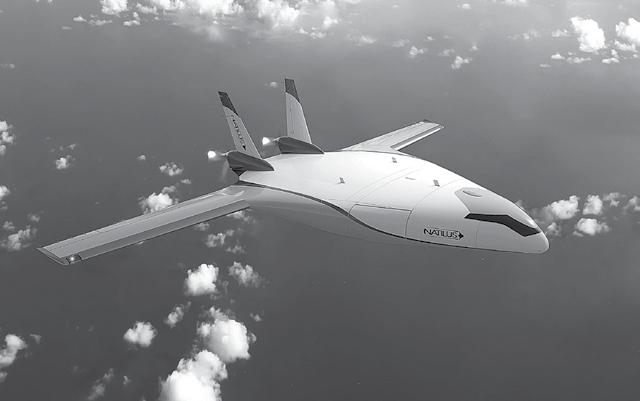
of this technology. The global impact of efficient and affordable air cargo solutions extends to contributing to global economic development by connecting remote communities, facilitating international trade, and enhancing overall supply chain resilience.
(Top) MightyFly Autonomous Flight Success Paves the Way for Efficient Cargo Loading and Unloading;
TO
READ THE COMPLETE ARTICLE GET YOUR COPY NOW!
The landscape of autonomous air cargo solutions is riddled with a myriad of challenges, each requiring careful consideration for the successful integration of this innovative technology. Regulatory uncertainties pose a significant hurdle, with unclear rules and regulations surrounding unmanned aerial vehicles (UAVs), particularly for larger cargo drones. This lack of clarity creates uncertainty for companies regarding airspace access, operational restrictions, and certification requirements. Additionally, the slow pace of regulatory updates and differing regulations across
(Above) Natilus Says New Autonomous Aircraft To Enhance Rapid and Safe Logistics in Africa.


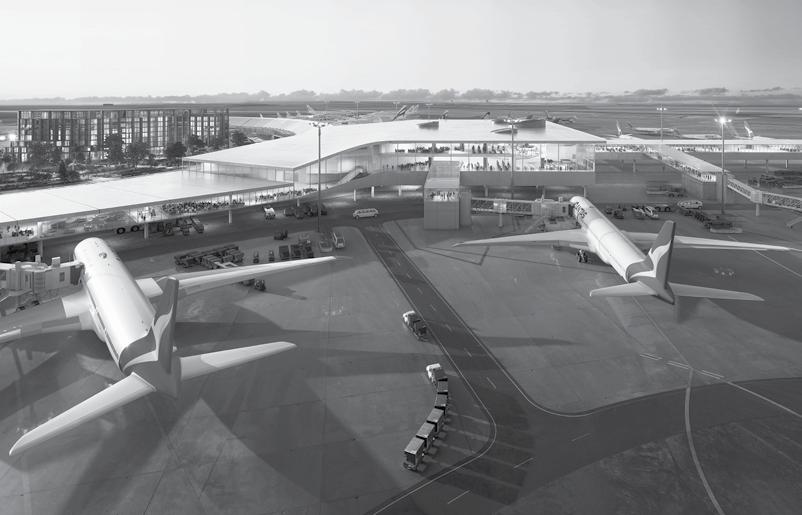
The year 2024 witnessed a powerful resurgence in domestic air travel fuelled a significant rebound, reshaping the competitive landscape and catalysing essential investments in infrastructure. Although the hum of activity approached pre-pandemic levels, the sector navigated headwinds such as operational snags, market consolidation, and the ever-present call for environmental responsibility. Governmental blueprints prioritising ecological sustainability and improved
connections across the vast continent actively moulded the trajectory of Australian aviation.
The Australian aviation network recorded approximately 3.7 million aircraft movements in the 2023–24 financial year, aligning closely with pre-COVID-19 levels. Notably, 70 new domestic routes were introduced, emphasising a shift towards pointto-point services catering to leisure travellers.
TO READ THE COMPLETE ARTICLE GET YOUR COPY NOW!
Group and Virgin Australia collectively control 98 per cent of the domestic market
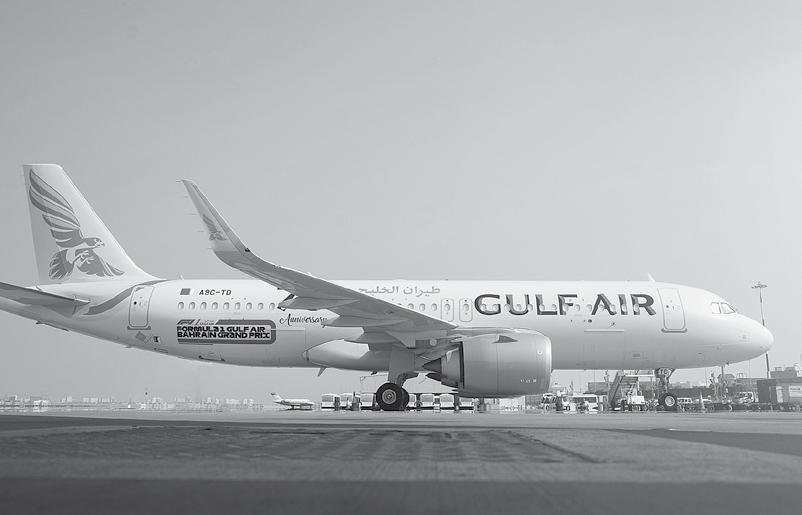
Bahrain’s civil aviation sector in 2024 painted a picture of notable expansion and inherent strength, cementing its crucial role as a central air transport nexus within the Gulf. Impressive figures in passenger volume and cargo handling, coupled with strategic alliances, underscored a year of robust performance. This upward momentum was propelled by forward-thinking investments in infrastructure, the growth of airline fleets, and enhanced air links that amplified Bahrain’s connectivity.
Bahrain International Airport (BIA), managed by Bahrain Airport Company (BAC), recorded a 7.3 per cent increase in passenger traffic, welcoming 9.4 million passengers in 2024 compared to 8.7 million in 2023. Flight movements totalled 98,596, comprising 49,282 arrivals and 49,314 departures. This growth reflects the successful implementation of strategic initiatives aimed at enhancing Bahrain’s connectivity and service offerings.
TO READ THE COMPLETE ARTICLE GET YOUR COPY NOW!
The Aviation sector maintained an upward momentum propelled by some judicious investments in infrastructure
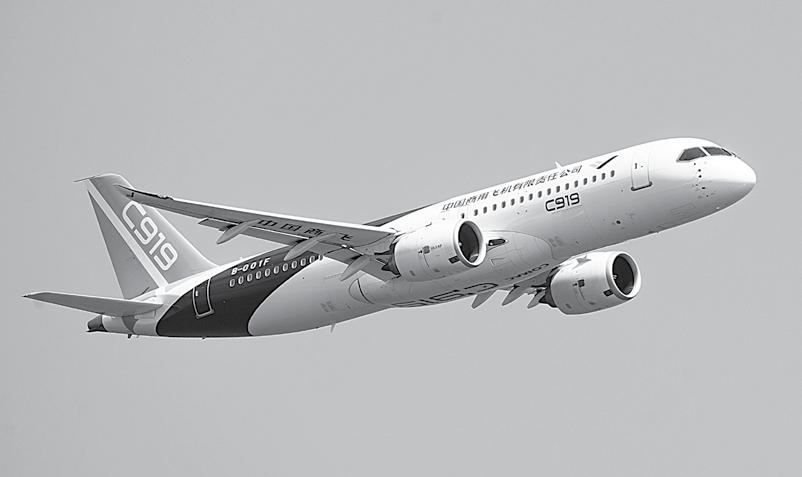
The year 2024 etched itself as a pivotal chapter in the recovery saga of China’s civil aviation industry. The sector not only eclipsed pre-pandemic performance metrics but also established unprecedented records in passenger throughput and operational efficiency. Bolstered by a formidable domestic appetite for travel, a steady revival in international routes, supportive government policies, and expansive infrastructure development, China emphatically reaffirmed its stature as a globally influential and vibrantly dynamic aviation powerhouse.
China’s civil aviation industry recorded approximately 730 million passenger trips in 2024, according to data released by the Civil Aviation Administration of China (CAAC) and the State Council Information Office. This represented an 18 per cent year-on-year increase and exceeded pre-pandemic levels for the first time, underscoring the sector’s resilience and adaptability. Domestic traffic accounted for the lion’s share with over 640 million passenger trips—surpassing 2019 levels by more than 14 per cent. This growth was driven by rising consumer confidence, regional
TO READ THE COMPLETE ARTICLE GET YOUR COPY NOW!
The successful rollout of the C919 reflects China’s growing capability in producing next-generation aircraft

Asignificant revitalisation characterised Hong Kong’s civil aviation sector in 2024. The skies above witnessed a substantial upswing in both passenger and freight traffic, complemented by strategic advancements in infrastructure and the embrace of cuttingedge technologies. These pivotal developments served to reinforce the position of Hong Kong International Airport (HKIA) as a preeminent global aviation centre.
HKIA witnessed a robust recovery in passenger traffic throughout 2024. The airport handled approximately 53.1 million passengers during the year, representing a 34.3 per cent increase compared to 2023. Flight movements also rose by 31.6 per cent year-on-year, totalling 3,63,305 operations. The growth was particularly notable in routes connecting to Southeast Asia, Mainland China, and Japan, driven by increased travel demand during holiday periods and the addition of new flight services.
TO READ THE COMPLETE ARTICLE GET YOUR COPY NOW!
Development of the SKYCITY project aims to transform HKIA into an “Airport City”
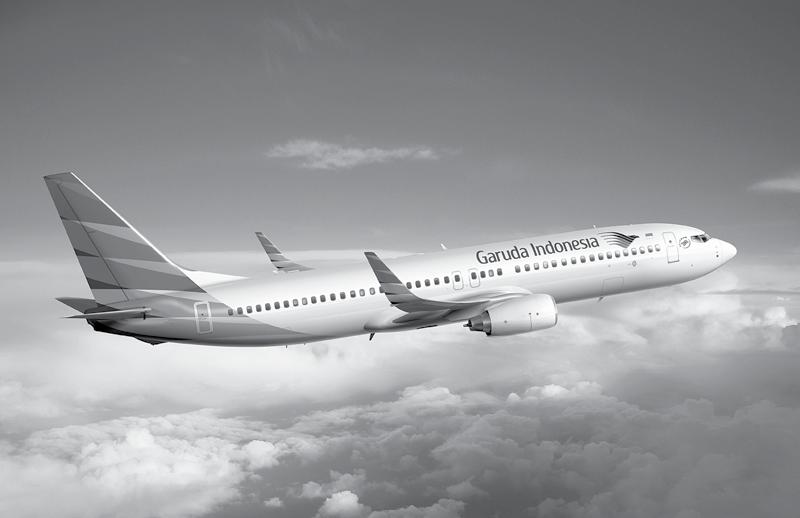
Indonesia’s civil aviation landscape in 2024 showcased a compelling recovery, marked by substantial growth in the movement of both people and goods. This resurgence underscored the inherent adaptability of the industry and its indispensable contribution to the nation’s broader economic advancement.
In December 2024, domestic air travel saw a remarkable increase, with 5.9 million passengers
departing, reflecting a 19.29 per cent rise from November. This surge contributed to a total of 63.7 million domestic passengers for the year, a 1.76 per cent increase compared to 2023. International passenger numbers also experienced a substantial uptick, reaching 19.0 million, marking a 21.46 per cent growth year-on-year.
TO READ THE COMPLETE ARTICLE GET YOUR COPY NOW!
The freight sector mirrored the positive trend, with domestic air freight increasing by 9.82 per cent in
Limitations in fleet capacity and escalating airfares remained as major challenges in the growth of the aviation sector
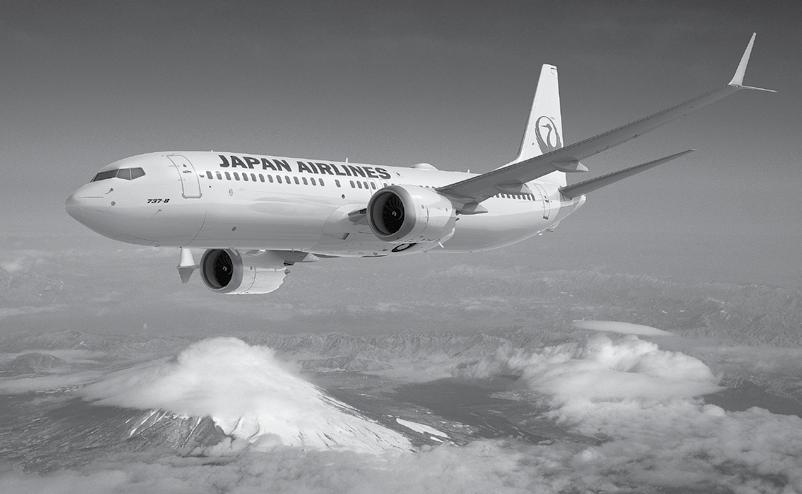
TH e year 2024 marked a period of significant resilience and expansion for Japan’s civil aviation sector as it rebounded from the challenges imposed by the pandemic. Valued at $16.9 billion, the market is projected to soar to $31.8 billion by 2033, reflecting a robust compound annual growth rate (CAGR) of 6.7 per cent. This upward trajectory is fuelled by a surge in domestic travel, continuous upgrades to infrastructure, and a strong commitment to environmentally sound practices.
y Domestic Travel: Domestic air travel experienced a robust resurgence. Haneda Airport’s busiest domestic routes in 2024 included Sapporo-Chitose (9 million passengers), Fukuoka (8.6 million), and Naha (5.9 million). Kobe Airport also reported handling over 3.5 million passengers, underscoring the vitality of regional air travel.
y International Travel: Japan welcomed a record 17.8 million foreign visitors between January and June 2024, marking a new half-year high. This surge in tourism, while beneficial ec-
Aviation was on an upward trajectory, fuelled by a surge in domestic travel and a strong commitment to environmentally sound practices

Malaysia’s civil aviation sector in 2024 demonstrated notable resilience and growth, evidenced by a strong rebound in passenger numbers, strategic enhancements to infrastructure, and ongoing efforts to modernise airline fleets. Despite navigating operational complexities, the industry achieved considerable progress in its journey back to pre-pandemic levels, propelled by increased international air connections and supportive governmental initiatives.
Malaysia Airports Holdings Berhad (MAHB) reported a notable increase in passenger movements, with 65.0 million passengers handled in the first half of 2024, representing a 15.8 per cent rise compared to the same period in 2023. International passenger movements saw a significant uptick of 28.9 per cent, reaching 34.1 million passengers. This growth was bolstered by the introduction of six new airlines operating in Malaysia, including
TO READ THE COMPLETE ARTICLE GET YOUR COPY NOW!
Malaysia Airlines continued its fleet renewal strategy with aims to operate a narrow-body fleet of 55 new-generation Boeing 737 MAX aircraft by 2030 and 20 Airbus A330neo wide-body jets by 2028.
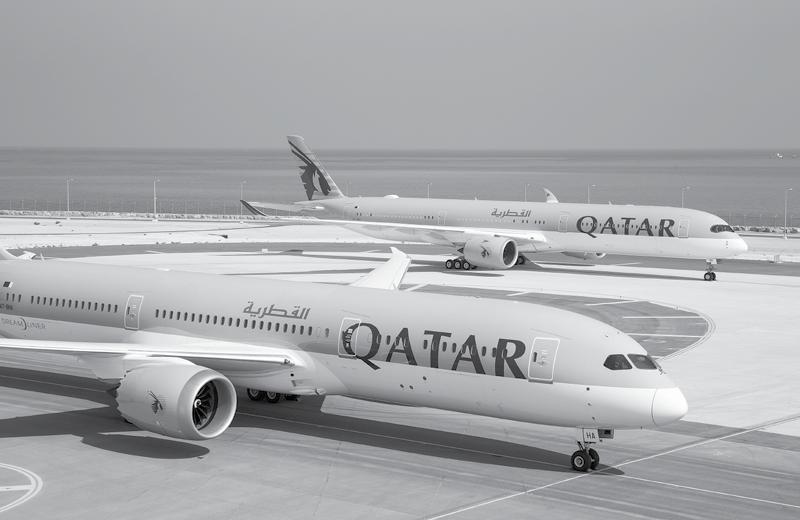
The year 2024 stands out as a landmark period for Qatar’s civil aviation domain, distinguished by unprecedented achievements, ambitious strategic expansions, and a strengthened dedication to operational excellence. The synergistic efforts of Qatar Airways, the Qatar Civil Aviation Authority (QCAA), and Hamad International Airport (HIA) have firmly established the nation as a formidable force within the global aviation arena.
In the fiscal year 2023/24, Qatar Airways reported its most robust financial performance to date, achieving a net profit of QAR 6.1 billion (approximately $1.7 billion), a 39 per cent increase from the previous year. Total revenue reached QAR 81 billion ($22.2 billion), with an EBITDA margin of 24 per cent, amounting to QAR 19.1 billion ($5.2 billion).
TO READ THE COMPLETE ARTICLE GET YOUR COPY NOW!
Hamad International Airport (HIA) was recognised as the “World’s Best Airport” and “Best Airport in the Middle East” by Skytrax in 2024
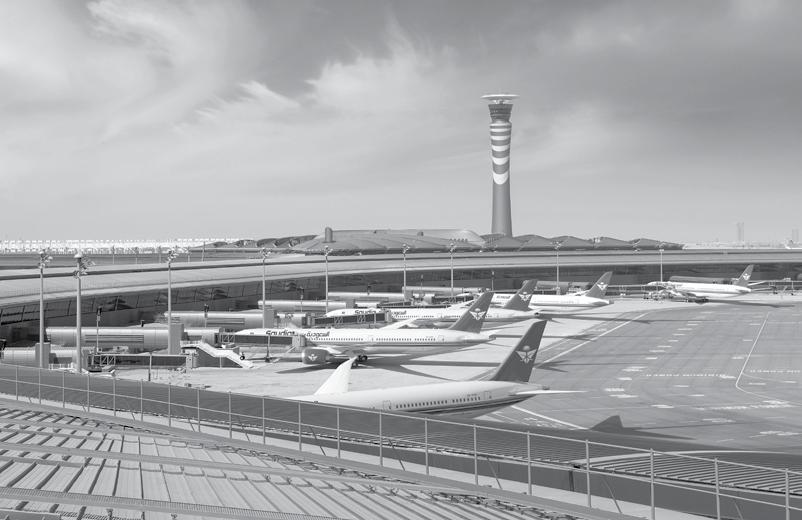
Saudi Arabia’s civil aviation sector in 2024 reached unprecedented heights, a direct result of the nation’s strategic investments and transformative reforms under the umbrella of Vision 2030. The General Authority of Civil Aviation (GACA) reported substantial increases across key performance indicators, highlighting the sector’s inherent strength and its critical role in the Kingdom’s economic diversification strategy.
Saudi Arabia’s airports collectively handled over 128 million passengers in 2024, marking a 15 per cent increase compared to 2023 and a 25 per cent rise over pre-pandemic levels. This surge comprised 59 million domestic and 69 million international travellers, highlighting a robust recovery and growing global connectivity.
TO READ THE COMPLETE ARTICLE GET YOUR COPY NOW!
The four primary airports—King Khalid International (Riyadh), King Abdulaziz International
Saudi Arabia’s Vision 2030 aims to diversify the economy and enhance the aviation sector’s contribution to the national GDP
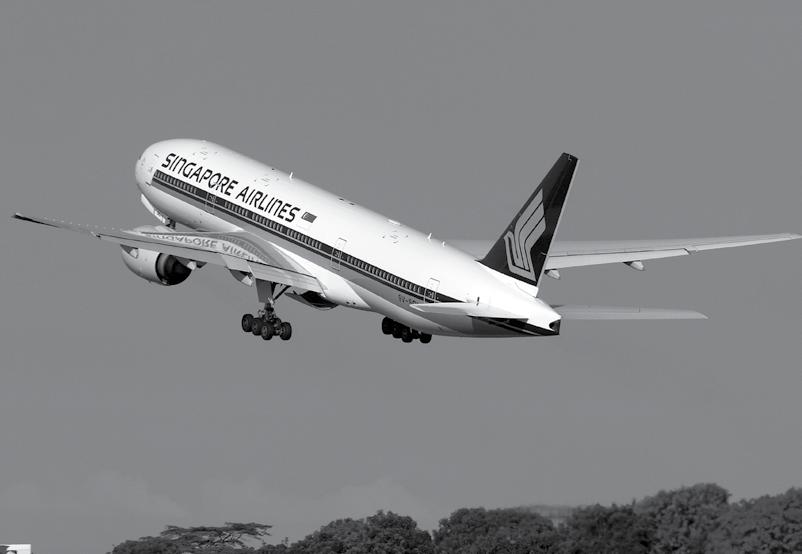
Singapore’s civil aviation sector in 2024 exhibited remarkable resilience and growth, approaching a complete recovery from the profound impact of the COVID-19 pandemic. The year was characterised by a significant resurgence in passenger traffic, strong financial outcomes for key players in the aviation ecosystem, and strategic initiatives focused on sustainability and fostering innovation.
Changi Airport, Singapore’s primary aviation hub, handled 67.7 million passengers in 2024, representing 99.1 per cent of its pre-pandemic traffic in 2019. This marks a 14.8 per cent increase from the 58.9 million passengers in 2023. December 2024 was the busiest month, with 6.41 million passengers, matching December 2019 levels.
TO READ THE COMPLETE ARTICLE GET YOUR COPY NOW!
Singapore Airlines (SIA) revenue reached an all-time high and achieved a record net profit for the fiscal year ending March 2024
CHAPTER 11

South Korea’s civil aviation sector in 2024 demonstrated remarkable resilience and growth, successfully navigating the challenges posed by the pandemic and positioning itself as a pivotal player within the global aviation landscape.
AIRLINE INDUSTRY PERFORMANCE
y Korean Air reported a record annual revenue of KRW 16.1 trillion (approximately $11 billion)
Korean Air’s acquisition of Asiana Airlines in December 2024 has consolidated its position as one of Asia’s largest carriers
in 2024, marking a 10.6 per cent increase from the previous year. The airline’s operating profit rose by 22.5 per cent to KRW 2 trillion, reflecting strategic capacity adjustments and enhanced premium services. However, passenger revenue experienced a three per cent decline in Q4, attributed to ongoing global supply chain recoveries. Conversely, cargo revenue surged by nine per cent in the same quarter, driven by increased e-commerce shipments from China. The completion of Korean Air’s acquisition of
TO READ THE COMPLETE ARTICLE GET YOUR COPY NOW!
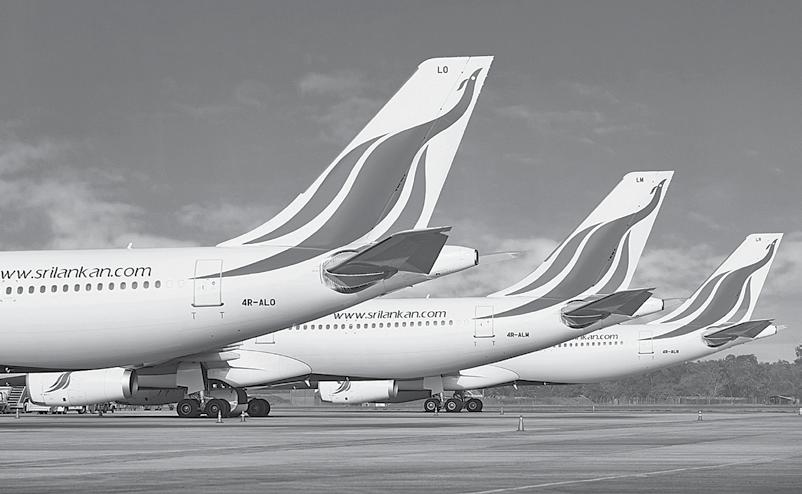
Sri Lanka’s civil aviation sector in 2024 experienced a significant upswing, evidenced by notable increases in passenger figures, aircraft movements, and cargo volumes. This growth trajectory reflects the nation’s strategic focus on infrastructure development, policy adjustments, and dedicated efforts to enhance its global air connectivity.
PASSENGER TRAFFIC: A ROBUST RECOVERY
Sri Lanka’s airports collectively handled approxi-
mately 8.8 million passengers in 2024, representing a 17.69 increase compared to the previous year. Bandaranaike International Airport (BIA) remained the primary hub, serving over 30 international airlines, including top-tier carriers such as Emirates, Qatar Airways, Singapore Airlines, Etihad Airways, and Turkish Airlines. The resumption of services by airlines like Thai Airways, Aeroflot, and Cathay Pacific Airways, along with new entrants such as Jetstar Asia and Red Wings Airlines, contributed to the surge in passenger traffic.
TO READ THE COMPLETE ARTICLE GET YOUR COPY NOW!
Sri Lanka aims to position itself as a regional aviation hub by leveraging its strategic location, enhancing connectivity to key markets in South Asia, Southeast Asia, and the Middle East

The Taiwanese civil aviation sector in 2024 demonstrated a robust recovery, characterised by significant growth in passenger traffic, strategic investments in infrastructure, and a renewed emphasis on both environmental sustainability and technological advancement.
PASSENGER TRAFFIC: STRONG REBOUND ACROSS ALL SEGMENTS
In 2024, Taiwan’s total air passenger volume reached approximately 52 million, a substantial increase from 15.5 million in 2022, indicating a strong post-pandemic recovery.
y International and Cross-Strait Passengers: Accounted for 41 million travellers, reflecting a significant resurgence in global travel demand.
y Domestic Passengers: Remained stable at 11 million, underscoring the continued importance of internal connectivity. This growth trajectory positions Taiwan’s aviation sector on a path to surpass pre-pandemic levels in the coming years.
AIRPORT PERFORMANCE: TAOYUAN LEADS THE RECOVERY
TO READ THE COMPLETE ARTICLE GET YOUR COPY NOW!
Taiwan Taoyuan International Airport (TPE), the nation’s primary international gateway, reported:
Tigerair Taiwan, the nation’s sole low-cost carrier, continues to expand its network, contributing to increased passenger volumes
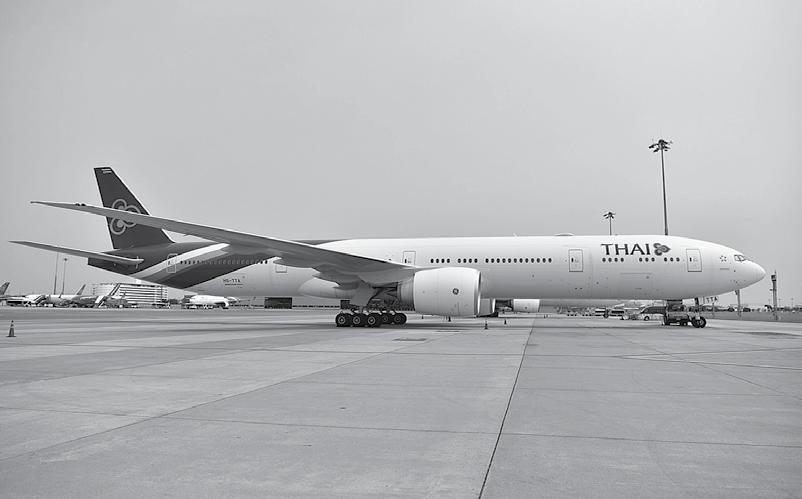
Thailand’s civil aviation sector in 2024 showcased a strong rebound, nearing pre-pandemic levels in both passenger numbers and flight operations. This resurgence was fuelled by increased demand for both domestic and international travel, strategic expansions by airlines, and significant developments in airport infrastructure. Key hubs such as Suvarnabhumi, Don Mueang, and Phuket experienced substantial growth, while carriers like Thai Airways reported strong financial and operational results. Government initiatives
prioritising infrastructure upgrades, digitalisation, and sustainability further propelled the industry’s positive momentum.
y Suvarnabhumi Airport (BKK): Handled approximately 62.2 million passengers in 2024, marking a 16.15 per cent increase from the previous year and surpassing its designed capacity of 45 million passengers annually.
TO READ THE COMPLETE ARTICLE GET YOUR COPY NOW!
y Don Mueang International Airport (DMK):
Thai government is investing in expanding six major international airports, including Suvarnabhumi and Don Mueang, to support anticipated passenger growth

The UAE’s civil aviation sector in 2024 witnessed a significant resurgence, managing approximately 147.8 million travellers, a 10 per cent increase from the preceding year. This growth encompassed 41.6 million inbound, 41.7 million outbound, and 64.4 million transit passengers. On a daily basis, the network accommodated over 4,00,000 individuals and handled more than 10,000 tonnes of freight. Air traffic movements reached a historic high of 1.03 million flights. Correspondingly, the workforce expanded
to include over 9,600 pilots and nearly 36,000 cabin crew members.
AIRLINE PERFORMANCE AND FINANCIAL HIGHLIGHTS
Emirates Airline Emirates reported a record annual profit of $5.2 billion for the fiscal year ending March 31, 2025, up from $4.7 billion the previous year. The airline carried 53.7 million passengers, a three per cent increase, and expanded seat capacity by four per cent.
TO READ THE COMPLETE ARTICLE GET YOUR COPY NOW!
Foresight and investments continue to spur United Arab Emirates’ civil aviation sector with notable expansion marked by record-breaking passenger figures
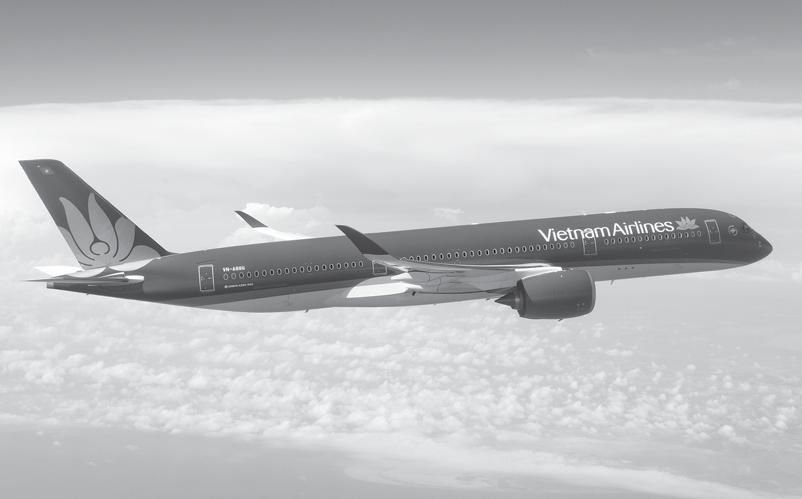
Vietnam’s civil aviation sector in 2024 demonstrated remarkable resilience and growth, successfully navigating global challenges to achieve significant milestones. The industry’s recovery was propelled by strategic expansions, infrastructural developments, and strong domestic travel demand.
In 2024, Vietnam Airlines, the national flag carrier, reported a record pre-tax profit of VND 7.32
trillion (approximately $287.7 million), marking a significant turnaround after four consecutive years of losses. The airline’s revenue surged to VND 114.7 trillion ($4.5 billion), a 23 per cent increase from the previous year.
The airline transported 22.7 million passengers and 314,700 metric tonnes of cargo, reflecting yearon-year increases of eight per cent and 40 per cent, respectively. The seat occupancy rate reached 80.6 per cent, with an average of 11 flight hours per aircraft per day, a 25 per cent improvement over 2023.
TO READ THE COMPLETE ARTICLE GET YOUR COPY NOW!
Vietnam’s civil aviation market in 2024 exhibited a strong trajectory of recovery, propelled by strategic network expansions and a focused emphasis on operational efficiency


A brief overview at the overall Indian Civil Aviation market during 2024
BY SP’S CORRESPONDENT
The Bharatiya Vayuyan Adhiniyam 2024, introduced by the Minister of Civil Aviation Rammohan Naidu, was passed by Lok Sabha on August 9, 2024 and by Rajya Sabha on December 5, 2024. The Bill, after receiving assent from the President, the Central Government appointed January 1, 2025 as the date on which the provisions of the said Act, shall come into force. The Bharatiya Vayuyan Adhiniyam, 2024 is a legislative reform aimed at modernising India’s aviation sector by re-enacting the Aircraft Act, 1934, in alignment with contemporary needs and global standards. In line with the Prime Minister’s call to remove colonial-era influences, this Adhiniyam addresses the need for clarity, efficiency, and ease of doing business in the aviation industry. The new legislation will foster indigenous manufacturing under Make in India and Atmanirbhar Bharat initiatives, align with international conventions like the Chicago Convention and ICAO, and streamline regulatory processes, such as simplifying the issuance of licenses. The Adhiniyam removes redundancies and provides provisions for appeals. Ultimately, the Bharatiya Vayuyan Adhiniyam, 2024 aims to revolutionise India’s aviation sector, enhancing safety, innovation, growth, and global compliance.
Under the chairmanship of Union Minister of Civil Aviation Rammohan Naidu, Ministry successfully organised the 2nd APAC-MC on 11th and 12th September, 2024 in New Delhi. As a major achievement, Delhi Declaration was proclaimed by Prime Minister of India Narendra Modi during the conference. The conference was attended by Ministers and high-level dignitaries from twenty-nine (29) Asia Pacific countries. Further, the conference was also attended by other aviation related International Organisations such as IATA, ACI, etc and representatives from ICAO.
EXPANSION OF AIRPORTS AND TERMINALS
Significant infrastructure development included laying the foundation for new terminals at Varanasi, Agra, Darbhanga, and Bagdogra. The Prime Minister Narendra Modi also inaugurated airports in Sarsawa, Rewa, and Ambikapur, strengthening regional connectivity.
INAUGURATION OF AIRPORTS IN UTTAR PRADESH
TO READ THE COMPLETE ARTICLE GET YOUR COPY NOW!
Prime Minister Narendra Modi inaugurated new
The Bharatiya Vayuyan Adhiniyam, 2024 is a legislative reform aimed at modernizing India’s aviation sector by re-enacting the Aircraft Act, 1934, in alignment with contemporary needs and global standards
UDAN has boosted regional connectivity with 609 routes, shaping India’s aviation growth as airlines expand and the government plans 50 new airports to meet rising demand
BY AYUSHEE CHAUDHARY
India’s aviation sector has witnessed a remarkable transformation in the past decade, driven by ambitious policies that prioritise connectivity, accessibility, and economic growth. At the heart of this transformation lies the UDAN (Ude Desh Ka Aam Nagrik) initiative, launched in 2016 under the Regional Connectivity Scheme (RCS). More than just a policy initiative, UDAN has democratised air travel in the nation, bringing smaller cities and remote regions into the aviation network while fueling economic activity, tourism, and employment.
With over 3,100 flights operating nationwide, this achievement highlights India’s growing prominence in the global aviation landscape. The UDAN scheme has been instrumental in this transformation, operationalising 609 routes, including helicopter services, and seamlessly connecting states and Union Territories across the country.
Unlike traditional government-led infrastructure projects, UDAN operates on a market-driven model,
where airlines assess demand on specific routes and submit proposals during a bidding process. To encourage connectivity to less profitable destinations, the government provides Viability Gap Funding (VGF), which bridges the financial shortfall airlines face when serving these routes. This model ensures that connectivity expansion is based on real demand rather than arbitrary planning.
Beyond financial assistance, UDAN thrives on a multi-stakeholder collaboration between airlines, airport operators, and government agencies. The Airports Authority of India (AAI) has played a crucial role by waiving landing and parking charges at RCS airports, removing Terminal Navigation Landing Charges (TNLC), and offering discounted navigation fees. Additionally, the Central Government has introduced policy measures such as capping excise duty on Aviation Turbine Fuel (ATF) at two per cent for three years at UDAN airports, making operations more cost-effective. State governments have also stepped in by reducing VAT on ATF to as low as one per cent for a decade, while offering logistical support like security, fire services, and electricity at subsidised rates.
TO READ THE COMPLETE ARTICLE GET YOUR COPY NOW!
“This Budget propels us toward our vision of Viksit Bharat 2047, reinforcing the Government’s commitment to enhancing regional connectivity with the idea of ‘Ease of Travel’.” – Union Civil Aviation Minister Rammohan Naidu
The under utilised capabilities of helicopters in India highlights the need for Government and Ministry of Civil Aviation assistance to navigate various challenges and leverage the abundant opportunities available
BY SWAATI KETKAR
Indian aviation is one of the fastest growing aviation markets globally having third largest market in terms of domestic capacity following US and China. In 2023, a whooping 133 new planes were inducted by different commercial airlines recording a 51 per cent rise over 2022. The post-COVID Indian civil aviation recovery market is soaring. In comparison, a rather gloomy picture greets the eye when we ponder over the helicopter industry in India. A little deep study into the helicopter market, leaves one with a lot of debatable questions like what exactly is lacking, why is India’s helicopter market still untapped? Why does a country with a population of 140 crores and counting has a mere 250 helicopters with just 1,900 heliports? Such figures make one wonder – Why is the helicopter industry receiving step-motherly treatment at the hands of the Ministry?
One of the key reasons for this stagnation as per Airbus is perception of helicopters in the minds of Indian population at large that ‘helicopters are only for rich.’ Due to this mental image the citizen has largely remained disconnected from its benefits and Governments have baulked from backing an idea that does not resonate with the masses. Echoing these views, Amit Dutta, Managing Director, Hunch Mobility, feels that helicopters are often perceived as a luxury reserved for VVIPs, celebrities, and politicians, overshadowing their fundamental role in enhancing accessibility to remote destinations and providing unparalleled efficiency. This perception that helicopters are exclusively
for the elite has contributed to their underutilisation in addressing broader transportation needs. Along with perception, there is a lack of awareness regarding the efficiency and convenience of helicopters especially regarding the accessibility in remote locations adds Dutta. “This limited fleet is further compounded by underutilisation of helipads and burdened with regulatory hurdles.”
Globally, employment of helicopters in law enforcement and emergency medical services enhances their operational viability. In India, these services are practically non-existent. “Poor consumer demand resulting in limited growth is a relevant challenge while alienation to technology absorption impeding this demand is unexplainable,” says Captain Peeyush Kumar of HeliGo Charter services. Countries leading the ‘pack’ of helicopter operations like Norway, Switzerland and Germany, have embraced helicopter-based transfers under Performance Based Navigation (PBN) concept which is a helicopter-specific operational alternative developed by ICAO for all weather, day/night operations from heliports. “Indian helicopter sector on the other hand is content with its legacy ‘sunrisesunset, good-weather-only’ window from heliports. It is only unfortunate that the dismal safety record of helicopter accidents possible to be offset through aforesaid PBN based operations remain estranged in India,” Captain Kumar adds. Additionally, poor safety record, non-reliability of planned schedule owing to traditional heliport operations are the primary tie-downs of Indian helicopter industry.
TO READ THE COMPLETE ARTICLE GET YOUR COPY NOW!
Globally, employment of Helicopters in Law Enforcement and Emergency Medical Services enhances their operational viability. In India, these services are practically non-existent.
As India prepares for the launch of air taxi services in 2026, with plans to connect high-traffic areas, Directorate General of Civil Aviation (DGCA) has revealed the regulatory framework for ‘Vertiports,’ paving the way for air taxis to become operational in India
BY SANJAY BHATNAGAR
Launch of air taxi service in India is being deliberated in various aviation circles for more than three years. We all have been talking about flying cars taking us over congested traffic in a safe manner, it no longer is science fiction. In India, recently the issue has generated lots of interest amongst common citizens after the Directorate General of Civil Aviation (DGCA) last month revealed the regulatory framework for ‘Vertiports’, paving the way for air taxis to become operational in India. Prior to that the DGCA had issued airworthiness criteria for type certification of vertical takeoff and landing capable aircraft (VCA).
Vertiports will be used by passengers to board and alight from air taxis, battery charging and parking these eVTOLs. As the acronym suggests, an electric vertical take-off and landing aircraft uses electric power to hover, take off and land vertically.
On September 12, 2024, Prime Minister Narendra Modi announced to the nation, “The day is not far when travel by air taxi will be a reality.” He chose to announce this while addressing the second Asia Pacific Civil Aviation Ministers Conference on Civil Aviation, being hosted in collaboration with the UN’s International Civil Aviation Organization
(ICAO), attended by over 300 representatives from 29 countries.
In India, launch of air taxi services is being planned in 2026. Agencies involved are claiming to be able to do the 30 km trip between Gurugram to Noida in less than seven minutes as compared to 90 minutes by road.
The issue of air taxi falls under the ambit of Urban Air Mobility (UAM). It refers to a system of air transportation that utilises electric vertical takeoff and landing (eVTOL) aircraft to transport passengers and cargo within urban and suburban areas. The main goal of UAM is to provide a fast, efficient and sustainable alternative to ground-based transportation, thereby reducing traffic congestion and travel times.
UAM is the use of small, highly automated aircraft to carry passengers or cargo at lower altitudes in urban and suburban areas, which have been developed in response to traffic congestion. It usually refers to existing and emerging technologies such as traditional helicopters, vertical-takeoff and landing aircraft (VTOL), electrically propelled vertical-takeoff and landing aircraft (eVTOL), and unmanned aerial vehicles (UAVs).
TO READ THE COMPLETE ARTICLE GET YOUR COPY NOW!
InterGlobe Enterprises and Archer Aviation have entered into a close to $1 billion deal to bring 200 allelectric air taxis to India by 2026
The Indian MRO industry is rapidly evolving into a global hub, fuelled by government initiatives, foreign investments, and growing domestic capabilities, positioning it for significant growth and self-reliance in the coming years
BY SWAATI KETKAR
Adecade back the aerospace maintenance, repair and overhaul (MRO) industry in India was a noshow. With just 3-4 major independent MROs struggling to make ends meet with basic airframe and line maintenance, there was nothing to talk or look forward to in Indian MRO circles. Fast-tract to today, when the Indian MRO industry is one of the fastest growing sectors of the world. Within a span of a little over a decade, the Indian MRO industry has grown by leaps and bounds and continues to grow at a super-fast speed. How did this transition happen? Why is the world suddenly started taking interest in investing in India’s MRO infrastructure and capabilities? Let us find out.
“The MRO industry in the country is expected to go up to $4 billion in seven years from the present $2 billion. Thus by 2030 India will develop a strong ecosystem for MRO services, driving innovation, and ensuring sustainable growth,” just as India’s Minister of Civil Aviation Rammohan Naidu said these words during question hour in Lok Sabha recently, the entire world’s focus increased on India’s MRO sector with just one question – How?
The government had the answer ready. India’s minister of civil aviation is leaving no-stone unturned to encourage the airline MROs, independent MROs
as well as oversees MROs and OEMs to come and invest in India. In fact, experts believe that MRO is the current pet project of MoCA and he fully intends to take it through. As a testimony to this, he rapidly changed some of the regulations stuck in red-tape like introduction of a uniform five per cent IGST rate on MRO items, introduction of 100 per cent FDI in MRO sector etc to name a few. The MRO fraternity in India welcomed this move with open arms. But is this enough to develop a sound $4 billion MRO ecosystem that India aspires? Definitely not! But its still a small and significant step towards achieving this goal.
Dassault Aviation is currently in the process of land acquisition near the upcoming Noida International Airport to establish a facility for the maintenance and overhaul of Rafale and Mirage 2000 fighter aircraft. This will allow India’s armed services to maintain their Rafale and Mirage 2000 fleets incountry. Dassault is already sourcing multiple titanium parts from various local companies in India with plans to add more local vendors to its supply chain. This will strengthen the overall aerospace manufacturing and MRO ecosystem in the country while realising the government’s Atmanirbhar Bharat initiative.
TO READ THE COMPLETE ARTICLE GET YOUR COPY NOW!
By 2030 India will develop a strong ecosystem for MRO services, driving innovation, and ensuring sustainable growth
Note: All figures shown for 2024 are estimates (E) and for 2034 are forecast projections (F). Data for additional Travel & Tourism indicators are available in the full report. For more details, visit https://researchhub.wttc.org.
1All values are in constant 2023 prices & exchange rates. As reported in March 2024.
2CAGR= Compound Annual Growth Rate.
Source: Oxford Economics, national sources and UN Tourism (formerly UNWTO).


This section is all about the flag bearers of aviation in Asia from regulatory bodies like the Ministries and Departments of Civil Aviation, Airports Authority, Airlines (including National Carriers), Operators and Associations.
Given here are exhaustive details of these leaders, like their profiles, the structure of their organisation and the contact details of their senior and middle management. These opinion leaders are the policy makers and decision takers not just for their organisation but for the aviation sector in their country as well. Their visions have a direct and indirect bearing on the entire sector in the region.
ORGANISATION CHART - CIVIL AVIATION SAFETY AUTHORITY (CASA), AUSTRALIA
Executive Officer
Air Navigation Transformation & Risk
National Operations and Standards
Chief Executive Officer / Director of Aviation Safety Board of CASA
Chief Audit Executive responsibilities
Regulatory Oversight
Safety, Risk and Intelligence Airworthiness and Engineering Continuous Improvement & Strategic Support
Transformation
Air Navigation, Airspace & Aerodromes
Stakeholder Engagement
Communications
Industry Complaints
Commissioner
Board Secretariat
Legal International and Regulatory Affairs
Source: www.casa.gov.au
Regulatory Services 2 Flight Standards
Emerging Technologies and Regulatory Change
Regulatory Services 1
Industry and Government Engagement
Client Services Centre
Surveillance
Legal Services
Internal Audit & International Affairs
Corporate Services Finance
Aviation Technical Workforce
People and Capability
Information Technology
Organisational Strategy, Change and Information Management
ORGANISATION CHART - MINISTRY OF TRANSPORTATION AND TELECOMMUNICATIONS, BAHRAIN
Minister of Transportation and Telecommunications
Telecommunications Directorate
Postal Sector Regulation Directorate
Assistant Undersecretary Resources and Information
Information Systems Directorate
Human Resources Directorate
Financial Resources Directorate
Source: https://mtt.gov.bh
Airlines
Undersecretary, Land Transportation and Post
Assistant Undersecretary, Post
Assistant Undersecretary, Land Transportation
Gulf Air Khalid Hussain Taqi Chairman
Gulf Air Dr Jeffrey Goh
Gulf Air Captain Qasim Ismaeel
Gulf Air Hanadi Alaali
Gulf Air Mazin Saleh
Gulf Air Adnan Hashim
Communications and Marketing Directorate
Undersecretary, Civil Aviation Affairs
Assistant Undersecretary, Air Navigation and Meteorology Services
Assistant Undersecretary, Air Transport and Aviation Safety and Security
WHO’S WHO - AIRLINES, BAHRAIN
Acting Chief Executive Officer
Chief Operations Officer
Chief Customer Experience Officer
Chief Technical Officer
Chief Financial Officer
Gulf Air Ahmed Naeemi Chief Technology Officer
Source: www.gulfair.com
Undersecretary, Ports and Maritime Affairs
Assistant Undersecretary, Ports Affairs
Assistant Undersecretary, Maritime Affairs
P.O. Box 138, Manama Bahrain
P.O. Box 138, Manama Bahrain
P.O. Box 138, Manama Bahrain
P.O. Box 138, Manama Bahrain
P.O. Box 138, Manama Bahrain
P.O. Box 138, Manama Bahrain
P.O. Box 138, Manama
WHO’S WHO - BAHRAIN AIRPORT COMPANY, BAHRAIN
Bahrain
Contact Designation Add 1 Add 2 Telephone
Khalid Hussain Taqi Chairman of the Board of Directors
Mohamed Yousif Al Binfalah Chief Executive Officer
Ayman Zainal Chief Commercial Officer
Ali Rashed Chief Airport Operations Officer
Leena Faraj Vice President - Strategic Implementation and Business Development
Source: www.bahrainairport.bh
Airport Road, Building 124, Block 224, Muharraq, +973 17353333
Airport Road, Building 124, Block 224, Muharraq, +973 17353333
Airport Road, Building 124, Block 224, Muharraq, +973 17353333
Airport Road, Building 124, Block 224, Muharraq, +973 17353333
Airport Road, Building 124, Block 224, Muharraq, +973 17353333
Organisation
Civil Aviation Administration of China
Civil Aviation Administration of China
Civil Aviation Administration of China
Civil Aviation Administration of China
Civil Aviation Administration of China
Source: www.caac.gov.cn
Song Zhiyong Administrator (Minister Level), Secretary of CPC Group, CAAC
Han Jun
Ma Bing
Liang Nan
Hu Zhenjiang
Deputy Administrator, Member of the CPC Group, CAAC
Deputy Administrator, Member of the CPC Group, CAAC
NO.155 Dongsi West Avenue, Dongcheng District, Beijing 100710
NO.155 Dongsi West Avenue, Dongcheng District, Beijing 100710
Dongsi West Avenue, Dongcheng District, Beijing 100710
Deputy Administrator, Member of the CPC Group, CAAC NO.155 Dongsi West Avenue, Dongcheng District, Beijing 100710
Deputy Administrator, Member of the CPC Group, CAAC NO.155 Dongsi West Avenue, Dongcheng District, Beijing 100710
ORGANISATION CHART - CIVIL AVIATION DEPARTMENT, HONG KONG
Director-General of Civil Aviation
Deputy Director-General of Civil Aviation (1)
Flight Standards and Airworthiness Division
Assistant Director-General (Flight Standards)
Air Traffic Engineering Services Division
Assistant Director-General (Air Traffic Engineering Services)
Source: www.cad.gov.hk
Air Traffic Management Division
Assistant Director-General (Air Traffic Management)
Airport Standards Division
Assistant Director-General (Airport Standards)
Deputy Director-General of Civil Aviation (2)
Air Services and Safety Management Division
Assistant Director-General (Air Services and Safety Management)
Finance Division
Chief Treasury Accountant
Administration Division – Departmental Secretary – Public Relations Officer
Chief Executive Officer (Management Review)
WHO’S WHO - CIVIL AVIATION DEPARTMENT, HONG KONG
Contact Designation Organisation Division Add 1 Add 2
Telephone E-mail Liu Chiyung,Victor, JP DirectorGeneral of Civil Aviation Civil Aviation Department – Level 5, Office Building, Civil Aviation Department Headquarters,
Wong Clara Deputy DirectorGeneral of Civil Aviation (1)
Dominic Chow Winghang Deputy DirectorGeneral of Civil Aviation (2)
KONG Kwok Piu, Bill
Civil Aviation Department – Level 5, Office Building, Civil Aviation Department Headquarters,
Civil Aviation Department – Level 5, Office Building, Civil Aviation Department Headquarters,
Chief Executive Officer (Management Review) Civil Aviation Department
YU Kin Ming, Kimberly Senior Executive Officer (Management Review)
Level 5, Office Building, Civil Aviation Department Headquarters,
1 Tung Fai Road, Hong Kong International Airport, Hong Kong
1 Tung Fai Road, Hong Kong International Airport, Hong Kong
1 Tung Fai Road, Hong Kong International Airport, Hong Kong
1 Tung Fai Road, Hong Kong International Airport, Hong Kong
Civil Aviation Department – Level 5, Office Building, Civil Aviation Department Headquarters, 1 Tung Fai Road, Hong Kong International Airport, Hong Kong
+852 2910 6363 vcyliu@cad. gov.hk
+852 2910 6328 cwong@cad. gov.hk
+852 2910 6356 dwhchow@cad. gov.hk
+852 2910 6860 bkpkong@cad. gov.hk
+852 2910 6861 kkmyu@cad. gov.hk
TO READ THE COMPLETE ARTICLE GET YOUR COPY NOW!
MINISTRY OF CIVIL AVIAITON: ORGANISATION CHART
Minister of Civil Aviation Minister of State for Civil Aviation Secretary
JS(ACA)
DIR (SM) US (JPS) DT Section + PHL Aviation Exhibition/WINGS
DIR (RR) US(SPR) Agreement Section
DIR (RR) US(SN) Vigilance & AIAHL Section
JS(SG)
JS (RA)
CFC Pay & Account US Office
JS&FA
DS (VKA) US(SB) IT Section
DDG(PKT)
DS (AS) US (SSR) DG Section US (VPS) C&W, RTI & Reservation Cell DS (VKA) US (Vacant) Admin
JS(MSS)
DIR (OPS) US(VPS) Parliament Section US (IB) ER Section JD (ND) US(DN) AAI Section US(AK) RS Section
Sr. EA
DIR (OL) DD (OL) Hindi Section DIR (KSR) US (PA) AS Section JD (ND) US (SB) IF Section DIR (KSR) US (MKY) Skill Development Section
Surjeet Kumar Das, SO (Parliament) Krishna Swami, SO (ER) Manisha Arya, SO (Vig.) Yogesh Kumar, SO (AS) Ravi Raj, SO (SDIT) Sanjay Tomar, SO (Cash) Kaushal Upadhyay, SO (AAI) Deepak Yadav, SO (AAI)
Vijay Pratap Singh, US (VPS) Yogesh Govil, DD (OL) Sumit Soni, SO (Admn) Anupam Raja, SO (IFD) Ravindra Kumar Yadav, SO (DG) Balram Yadav, SO (C&W) Neeraj Nara, SO (A) Punit, SO (A) Ashwani Kumar, SO (DT) Ashish Soni, SO (AI)
Manoj Kumar Yadav, US(MKY) Amit Kumar Jha, US(AK) Indu Butani, US(IB) Padma Agnihotri, US(PA) Satya Prakash Ram Tripathi, US(SPR) Subir Narayan, US (SN) Sunil Singh Rawat, US (SSR) Deepak Nagpal, US (DN) Suresh Babu, US (SB)
O.P. Sharma, Dir (OPS) Kumar Saurabh Raj, Dir (KSR) Vijayant Kumar Arora, DS(VKA) Ambuj Sharma, DS (AS) Nayonika Dutta, Joint Director Lt. Col. Manish Kumar Singh, Director (OL) Jyoti Prakash Singh,US(JPS) Krishna K Singh, US(KKS): Under Posting
US (DN) AAI Section US(AK) AD Section DIR (JC) US (Vacant) General & Cash
Piyush Srivastava, Sr. EA Padam Lal Negi, JS&FA Shobhit Gupta JS(SG) Rubina Ali, JS(RA) Asangba Chuba Ao, JS (ACA) Pramod Kumar Thakur, DDG (PKT) Madhu Sudana Sankar, JS (MSS) Rohit Raj, Dir(RR) Joyanta Chakraborty, Dir(JC) Shankhesh Mehta, Dir(SM)
ORGANISATIONAL CHART - DIRECTORATE GENERAL OF CIVIL AVIATION
Director General of Air Transportation
Director Air Freight
Acting Director of Airport
Director Flight Safety
Source: https://hubud.dephub.go.id WHO’S WHO - AIRLINES, INDONESIA
Airline Contact Designation Add 1
Garuda Indonesia Marsekal TNI (Purn.) Fadjar Prasetyo
Secretary of the Directorate General of Air Transportation
Directorate of Surveillance Navigation
Director of Airworthiness and Aircraft Operations
President Commissioner / Independent Commissioner
Garuda Indonesia Chairal Tanjung Commissioner
Garuda Indonesia Glenny Kairupan Commissioner
Garuda Indonesia Timur Sukirno President Commissioner & Independent Commissioner
Garuda Indonesia Wamildan Tsani President and CEO
Garuda Indonesia Prasetio Director of Finance and Risk Management
Garuda Indonesia Ade R Susardi Director of Service and Commercial
Garuda Indonesia Tumpal Manumpak Hutapea Director of Operation
Garuda Indonesia Rahmat Hanafi Director of Maintenance
Citilink Prasetio President Commissioner
Citilink Dewa Kadek Rai President Director
Management Building, Garuda City, SoekarnoHatta International Airport
Management Building, Garuda City, SoekarnoHatta International Airport
Management Building, Garuda City, SoekarnoHatta International Airport
Management Building, Garuda City, SoekarnoHatta International Airport
Management Building, Garuda City, SoekarnoHatta International Airport
Management Building, Garuda City, SoekarnoHatta International Airport
Management Building, Garuda City, SoekarnoHatta International Airport
Management Building, Garuda City, SoekarnoHatta International Airport
Management Building, Garuda City, SoekarnoHatta International Airport
Management Building, Garuda City, SoekarnoHatta International Airport
Management Building, Garuda City, SoekarnoHatta International Airport
Tangerang 15111, +62 21 2560 1001
Tangerang 15111, +62 21 2560 1001
Tangerang 15111, +62 21 2560 1001
Tangerang 15111, +62 21 2560 1001
Tangerang 15111, +62 21 2560 1001
Tangerang 15111, +62 21 2560 1001
Tangerang 15111, +62 21 2560 1001
Tangerang 15111, +62 21 2560 1001
Tangerang 15111, +62 21 2560 1001
www.garudaindonesia.com
www.garudaindonesia.com
www.garudaindonesia.com
www.garudaindonesia.com
www.garudaindonesia.com
www.garudaindonesia.com
www.garudaindonesia.com
www.garudaindonesia.com
www.garudaindonesia.com
Cengkareng,Tangerang 15111 Indonesia +62 21-39509000 www.citilink. co.id
TO READ THE COMPLETE ARTICLE GET YOUR COPY NOW!
Cengkareng,Tangerang 15111 Indonesia +62 21-39509000 www.citilink. co.id
ORGANISATION CHART - CIVIL AVIATION BUREAU
General Affairs Division
Counselor, Minister’s Secretariat (Budget of the Civil Aviation Bureau)
Aviation Strategy Division
Assistant Vice-Minister (International Affairs/Aviation)
Aviation Network Department
Aviation Safety and Security Department
Air Navigation Services Department
*Regional Bureaus
*Affiliated Facilities & Institutions
Source: www.mlit.go
Planning Division
Counselor, Minister’s Secretariat (Airports the Kinki and Chubu Areas)
Aviation Industries Division
Airport Facilities Division
Capital Area Airports Division
Environment and Regional Development Division
Aviation Safety and Security Planning Division
Counselor, Minister’s Secretariat (Aviation Safety)
Airport Safety and Aviation Security Division
Flight Standards Division
Counselor, Minister’s Secretariat (Air Transport Safety)
Airworthiness Division
Air Navigation Services Planning Division
Air Traffic Control Division
Operations and Flight Inspection Division
Air Navigation Services Engineering Division
Regional Civil Aviation Bureau (Tokyo, Osaka)
Air Traffic Control Center (Sapporo, Tokyo, Fukuoka, Naha)
Aeronautical Safety College (Main Institute & Iwanuma Training Center)
Source: www.caam.gov.my
ORGANISATION CHART - CIVIL AVIATION AUTHORITY
Minister of Transport
QCAA President
Public
Human
Finance
Information
Rescues
General Administration for Aviation Regulatory and Oversight
General Manager
Source: https://caa.gov.qa
General
President’s
International
Internal
Planning
ORGANISATION CHART - GENERAL AUTHORITY OF CIVIL AVIATION
Board of Directors
Member of the Board of DirectorsRepresentative of the Ministry of Economy and Planning
Member of the Board of DirectorsRepresentative of the Ministry of Finance
Member of the Board of DirectorsRepresentative of the Ministry of Tourism
Member of the Board of DirectorsRepresentative of the Ministry of Commerce
Member of the Board of DirectorsRepresentative of the Ministry of Transport
Member of the Board of DirectorsRepresentative of the private sector
Member of the Board of DirectorsRepresentative of the private sector
Chairman of the Board of Directors
Aviation Investigation Bureau
Member of the Board of DirectorsRepresentative of the private sector External
Assistant to the President for Economic Policies and Air Transport
Assistant to the President for Aviation Security
Assistant to the President for Hajj and Umrah Services
Violation
Board of Directors Secretariat
General Manager of the President Office
The General Department for Startregy
The General Department for Privatization and Commercial Operation
The General Department for Quality and Customer Protection
The General Department for Internal Audit Vision Realization Office
General Department for Legal Affairs
General Department for International Cooperation
General Department for Marketing and Corporate Communication
Saudi Academy of Civil Aviation
GACA’s Representative Office at the ICAO
Assistant to the President for Aviation Standards
Assistant to the President for Support Services
Assistant to the CEO for Operation Assistant to the President for Airports Assistant to the President for Projects
Director (Internal Audit)
2 Deputy Director-General Authority Director General
Senior Director (Unmanned Systems Group)
International Relations Group
Advisor, Civil Aviation Advisory Group Air Navigation Services Group
1 Deputy Director-General/Chief Risk Officer
Senior Director (Safety Regulation Group)
Senior Director (Aviation Development Group)
Corporate Group
Unmanned Systems Group Safety Regulation Group
Aviation Development Group
Director (International Relations)
Director (Aeronautical Telecommunications & Engineering)
Director (Unmanned Systems Policy, Regulations and Operations)
Director (Singapore Aviation Academy) Singapore’s Representative on the Council of the ICAO
Director (Air Traffic Services)
Director (Air Traffic Management Plans and Development)
Director (Unmanned Systems Technology, Engineering and Planning)
Director (Corporate Development and Emergency Preparedness)
Director (Human Resource)
Director (Finance)
Director (Legal)
Director (Flight Standards)
Director (Airport Development and Planning
Chairman (Civil Aviation Medical Board)
Director (Air Transport)
Director (Corporate Communications)
Dirrector (Transformation Office)
Director (Aerodrome and Air Navigation Services Regulation)
Director (Airport Operations Regulation & Aviation Security)
Director (Airspace Policy)
Chief Technology Officer Chief Sustainability Officer
Director (Cybersecurity and Data Governance)
Director Safety Policy and Planning
Director (Airport Economic Regulation)
Director (Aviation Industry)
ORGANISATION CHART - OFFICE OF CIVIL AVIATION OF MINISTRY OF LAND, INFRASTRUCTURE AND TRANSPORT DG
Korea Office of Civil Aviation of Ministry of Land, Infrastructure and Transport (MOLIT) Deputy Minister
Source: www.koca.go.kr
152/1, Minuwangoda Road (Opposite Radar Tower), Katunayake +94 112 358 802 sldgca@caa. lk, dgcaoffice@ caa.lk
Director General of Civil Aviation’s Office
Air Vice Marshal Sagara Kotakadeniya Director General of Civil Aviation & Chief Executive Officer Civil Aviation Authority of Sri Lanka
152/1, Minuwangoda Road (Opposite Radar Tower), Katunayake +94 112 257 124 +94 112 358 807 (Ext.) 807 chairman@ caa.lk
Chairman’s Office
Sunil Jayarathne Chairman Civil Aviation Authority of Sri Lanka
vice-chairman@ caa.lk
152/1, Minuwangoda Road (Opposite Radar Tower), Katunayake +94 112 253 082 / +94 112 358 812 (Ext.) 813
Vice Chairman Civil Aviation Authority of Sri Lanka Chairman’s Office
adgca@caa.lk
152/1, Minuwangoda Road (Opposite Radar Tower), Katunayake +94 112 358 999 (Ext.) 999 / +94 112 255 542
Additional Director General’s Office
Additional Director General Civil Aviation Authority of Sri Lanka
ddgatsr@caa.lk
152/1, Minuwangoda Road (Opposite Radar Tower), Katunayake +94 112 358 863 (Ext.) 863 011 2253474
DDG (ATSR), DDG (CM), DDG (ASR), DG (FSR)
Civil Aviation Authority of Sri Lanka
R.M. Wanniappa Deputy Director General (Air Transport and Security Regulation) (Corporate Affairs & Economic Regulation)
ddgasr@caa.lk
Katunayake +94 112 253 496
152/1, Minuwangoda Road (Opposite Radar Tower),
DDG (ATSR), DDG (CM), DDG (ASR), DG (FSR)
Civil Aviation Authority of Sri Lanka
ddgfsr@caa.lk
152/1, Minuwangoda Road (Opposite Radar Tower), Katunayake +94 112 358 912 Ext 912
DDG (ATSR), DDG (CM), DDG (ASR), DG (FSR)
Civil Aviation Authority of Sri Lanka
dqia@caa.lk
Katunayake +94 112 358 962 Ext. 962
152/1, Minuwangoda Road (Opposite Radar Tower),
Civil Aviation Authority of Sri Lanka Quality and Internal Audit Section
152/1, Minuwangoda Road (Opposite Radar Tower), Katunayake +94 112 358 963 Ext. 963 mgriaqs@caa.lk
Civil Aviation Authority of Sri Lanka Quality and Internal Audit Section
152/1, Minuwangoda Road (Opposite Radar Tower), Katunayake +94 112 358 817 Ext. 817 mgrasm@caa.lk
Civil Aviation Authority of Sri Lanka Aviation Safety Monitoring
152/1, Minuwangoda Road (Opposite Radar Tower), Katunayake +94 112 358 816 Ext. 816 mgrlae@caa.lk
Civil Aviation Authority of Sri Lanka Legal Affairs and Enforcement Section
M.A.K. Prasanna Deputy Director General (Aeronautical Services Regulation)
Capt. Daminda Rambukwella Deputy Director General (Flight Safety Regulation)
Director (Quality and Internal Audit)
L.K. Premasiri Acting Director (Quality and Internal Audit)/Manager (Internal Audit and Quality Survey)
Samudra Chandrarathne Manager (Aviation Safety Monitoring)
J.A.T.C. Ariyarathne Manager (Legal Affairs & Enforcement)
152/1, Minuwangoda Road (Opposite Radar Tower), Katunayake +94 112 358 832 Ext. 832 davsec@caa.lk
Civil Aviation Authority of Sri Lanka Aviation Security Section
Aviation Security Section
152/1, Minuwangoda Road (Opposite Radar Tower), Katunayake +94 112 358 834 Ext. 834 scaiaps@caa.lk TO READ THE
R.G.T.P. Ramawickrama ManagerInformation and Communication Technology Civil Aviation Authority of Sri Lanka Information and Communication Technology Unit
152/1, Minuwangoda Road (Opposite Radar Tower), Katunayake +94 0112 358 894 Ext 894 mgrict@caa.lk Air Vice Marshal H.N.Abeysinghe (Retd.) DirectorAviation Security
Civil Aviation Authority of Sri Lanka
P.G.M. Tiroshana Senior Civil Aviation Inspector (Airport Security)
Sub-Committee
ORGANISATION CHART - CIVIL AVIATION AUTHORITY
The Civil Aviation Authority of Thailand
Corporate Strategy Department (CSD)
Legal Department (LEG)
Deputy Director (Safety)
Flight Operations Standards Department (OPS)
Airworthiness and Aircraft Engineering Department (AIR)
Personal Licensing Department (PEL)
Aerodrome Standards Department (AGA)
Air Navigation Services Standards Department (ANS)
Source: www.caat.or.th/en
Board of Commissioner Director
Audit Committee
Internal Audit Office (IAO)
Quality Assurance Department (QAD)
Aviation Safety Management Department (SMD)
Deputy Director (Security/Economic/Promotion)
Aviation Security and Facilitation Standards Department (SFD)
Economic Regulation Department (ERD)
Flight Formalities Department (FFD)
Aviation Industry Promotion Department (APD)
Aeronautical Information Services Department (AIS)
Deputy Director (Corporate Support)
Information and Communication Technology Department (ITD)
Human Resource Management Department (HRD)
Financial Accounting and Budgeting Department (FAB)
Audit Committee Investment and Strategy Comittee
Human Resources and Remuneration Committee
Executive Vice President Flight Operation Director
Operation Control Center
Flight Crew Division 999
Branch of VNA Flight Training Center
Subsidiaries & Associates
General Meeting of Shareholders
Board of Supervisors
Board of Directors Chief Executive Officer
Executive Vice President Sales Director
Marketing & Sales Departiment
Cargo Marketing & Planning Department
Branch of VNA Golden Lotus Center
Northern Branch of VNA
Southern Branch of VNA
VNA Oversea Branches & Regional Offices
Source: Vietnam Airlines Annual Report 2019
Executive Vice President Services Director
Passenger Services Department
Executive Vice President Technical Director Technical Department
Executive Vice President In Charge of Safety
Sefety-Quality Department
Executive Vice President In Charge of IT and External Investments
Carbin Crew Division Tan Son Nhat Operation Center
Supply & Material Management Department
Noi Bai Operation Center
Aviation Security Department
Aviation Center for Research & Implementation
Heritage Magazine
Branch of VNA Vietam Air Service Company
Information Technology Department
Other Executive Vice President
Corporate Planning & Development Department
Investment & Procurement Department
Finance & Accounting Department
Inspection and Auditing Department
Corporate Affairs Department
Human Resource Department
Legal Department
Brand & Communication Department

Pip Spence (AUSTRALIA)
Chief Executive Officer (CEO) and Director of Aviation Safety (DAS) Civil Aviation Safety Authority
Pip Spence commenced as the CEO and DAS on May 17, 2021. Before joining CASA, Pip was the Chief Operating Officer and Deputy Secretary for the Arts at the Department of Infrastructure, Transport, Regional Development, Communications and the Arts. Before that she was the Deputy Secretary for Transport. In this role, Pip was responsible for aviation

Dr Shaikh Abdulla bin
Ahmed Al Khalifa (BAHRAIN)
Minister of Transportation and Telecommunications
Dr Shaikh Abdulla bin Ahmed Al Khalifa is the Chairman of the Board of Trustees of the Bahrain Centre for Strategic, International and Energy Studies (Derasat) since 2017. In 2024, he was appointed Minister of Transportation and Telecommunications by a royal decree. He held the position

Mohamed Yusuf Al-Binfalah (BAHRAIN)
Chief Executive Officer (CEO), Bahrain Airport Company (BAC)
Mohamed Yousif Al Binfalah serves as
Chief Executive Officer of Bahrain Airport Company (BAC) with the responsibility of the management, operation and future strategy and development of Bahrain International Airport

Song Zhiyong (CHINA)
and airport policy and programme matters. Pip has held senior leadership roles across the Australian Public Service including:
y Department of the Prime Minister and Cabinet.
y the then Department of Broadband, Communications and the Digital Economy.
In that role Pip was closely involved in establishing the National Broadband Network and the associated reform of telecommunications regulations.
Pip commenced her career in the Department of Transport and Communications, where she worked in a number of aviationrelated areas. This included working in the office of the Minister for Transport.
of Deputy Secretary General of the Supreme Defence Council from 2022 to 2024.
Dr Al Khalifa’s extensive experience in foreign affairs includes serving as Undersecretary for International Affairs at the Ministry of Foreign Affairs from 2015 to 2021 and subsequently as Undersecretary for Political Affairs from 2021 to 2024.
He holds a Bachelor of Laws (LLB) from Jordan’s Applied Science University, a Master of Laws (LLM) from Queen Mary University of London, and a PhD in International Relations and Diplomacy from L’École des Hautes Études Internationales et Politiques in Paris.
(BIA). In addition, Mohamed is leading the $1 billion Airport Modernisation Program (AMP) with the aim of elevating the airport’s infrastructure and services in line with the highest levels of safety, security, technology and environmental standards. Mohamed joined BAC in 2012 and was previously the General Manager of DHL Aviation Service W.L.L. for eight years. Prior to this Mohamed held various senior management positions and worked in various industries. He holds a Bachelor’s degree in Mechanical Engineering and a Master’s in Business Administration.
Administrator (Minister Level), Secretary of CPC Group, CAAC
• Song Zhiyong, male, Han ethnicity. Born in August 1965.
• Song is a member of the CPC Group of the Ministry of Transport, Administrator of CAAC and Secretary of the CPC Group of CAAC.

VANESSA HUDSON, Chief Executive and Managing Director
Vanessa Hudson was appointed as Qantas Group Chief Executive and Managing Director on September 6, 2023.
She is a Member of the Safety, Health, Environment and Security Committee. Hudson is also a Director of a number of controlled entities of the Qantas Group.
Hudson was previously Group Chief Financial Officer for four years, including through the pandemic and the airline’s recovery.

ANDREW DAVID, CEO of Qantas Domestic, International and Freight Businesses
Andrew David has been a proven leader in the airline industry for over 30 years, culminating in his current role as CEO of Qantas Domestic, International and Freight businesses.
He joined the Qantas Group in 2013 and has held a number of roles including Chief Operating Officer for Qantas and Executive

DR JEFFREY GOH, Acting
Chief Executive Officer
Dr Jeffrey Goh, the CEO of Gulf Air Group Holding, brings with him a wealth of experience and expertise. Having served as the CEO of Star Alliance since 2017, Dr Goh has established himself as a respected figure in the global airline alliance. His tenure at Star Alliance spanned over a decade, during which he played various roles in shaping

MA CHONGXIA, Chairman
Ma Chongxian, aged 57, started his career in civil aviation industry in July 1988 and served as Vice President and a member of the Standing Committee of the Communist Party Committee of Air China from April 2010 to May 2021, and served as Vice General Manager and a member of the Leading Party Members’ Group of China National Aviation Holding Corporation Limited (“CNAHC”) from December 2016 to April 2021. He served as Deputy Secretary
She served as Qantas Chief Customer Officer, with responsibilities spanning all aspects of the customer experience and strategy.
Joining Qantas in 1994, she has held a variety of senior commercial, customer and finance roles across the Group, in Australia and overseas, including Executive Manager of Sales and Distribution, Senior Vice President for Qantas across the Americas and New Zealand, Executive Manager of Commercial Planning and Executive Manager for Product and Service. In these various roles, her responsibilities ranged from sales channels, revenue management and network planning, to transformation in catering, airports and network.
Vanessa has a Bachelor of Business and was admitted as a Member of the Institute of Chartered Accountants in 1994.
Director at Jetstar Japan. Andrew’s career has seen him work in the UK, Japan, Singapore, Australia and New Zealand. After starting his working life in technology and innovation, he progressed into executive leadership roles covering financial, commercial and operational accountability.
As Chairman of an IT business that was ultimately sold to a US private equity firm, Andrew gained valuable commercial insight as well as practical governance and board leadership. He has broad experience in leading large-scale successful change, including startups, mergers, acquisitions and transformation programmes.
the organization's success. Prior to his work at Star Alliance, he made significant contributions at the International Air Transport Association (IATA) and held a prominent position at a prestigious law firm, Beaumont and Son, in London.
With a deep understanding of the complexities of the aviation industry, Dr Goh is well-equipped to lead Gulf Air and Gulf Air Group Holding, a conglomerate that comprises the National Carrier of the Kingdom of Bahrain, Gulf Air, as well as Bahrain Airport Company, BAC Jet Fuel Company, and Gulf Aviation Academy. Additionally, the group holds substantial shares in Bahrain Airport Services and Bahrain Duty Free, reinforcing its significant presence in the aviation market.
of the Leading Party Members’ Group of CNAHC from April 2021 to September 2022, and a Director of CNAHC since May 2021.
TO READ THE COMPLETE ARTICLE GET YOUR COPY NOW!
He served as General Manager of CNAHC, and concurrently as President and Deputy Secretary of the Communist Party Committee of the Company from May 2021 to September 2022. Ma has served as a non-Executive Director of Cathay Pacific since June 2021, an Executive Director of the Company since July 2021 and the Vice Chairman of the Company from July 2021 to September 2022. He has served as the Chairman and secretary of the Leading Party Members’ Group of CNAHC, and the Chairman and Secretary of the Communist Party Committee of the Company since September 2022.

Ali Ahmed Alnaqbi
Chairman of the IBAC Governing Board; Founding and Executive Chairman, Middle East & North Africa Business Aviation Association (MEBAA)
Alnaqbi has served in the regional business aviation industry for more than 30 years. He founded MEBAA (Middle East & North Africa Business Aviation Association) in 2006 in Dubai representing the


Kurt Edwards
Middle East and North Africa region under the umbrella of IBAC. Alnaqbi is instrumental in driving the business aviation industry in the MENA region to new heights. He has been duly lauded by Governments in the region for his role and achievements in bringing about safety and efficiency.
Ali Ahmed Alnaqbi, was re-elected to Chair the governing board of the International Business Aviation Council (IBAC) for the second time in a row for a period of three years (2023-2025). Alnaqbi, the first Arab ever to head IBAC, has held the position of Chairman since 2020 and earlier served as Vice Chairman for three years.
Director General, International Business Aviation Council (IBAC)
Kurt Edwards has been Director General of International Business Aviation Council since September 1, 2012. Edwards has substantial experience in international aviation issues. Previous to coming to IBAC, he served in highlevel capacities with the International Affairs and Environment Offices of the US Federal Aviation Administration (FAA). He also led FAA outreach efforts while based in Brussels and Paris, as well as at ICAO on environmental matters.
Dawit Lemma
Chairperson, African Business Aviation Association (AfBAA)
Dawit Lemma is a seasoned aviation executive, entrepreneur, and advocate with over 25 years of experience spanning multiple continents. His expertise lies in aircraft ground handling, maintenance, aviation business development, and operational excellence,

Craig Middleton
Vice
Chairperson/Treasurer,
African Business Aviation Association (AfBAA)
Craig Middleton has over 30 years of expertise in aviation management, strategic business development, and operational leadership, Craig has consistently driven growth, innovation, and operational excellence across multiple international aviation organisations. As the Director of Sales and Account Management at General Aviation Services Ltd (G.A.S.),
backed by a solid technical foundation as a licensed commercial pilot and FAA-certified Airframe & Powerplant Mechanic. Dawit’s leadership extends beyond corporate success—his extensive board experience in global aviation organisations positions him as a strategic voice in industry governance and advocacy. He serves as a Board Director for Women in Aviation International (WAI), a board member of ISBAH within the International Business Aviation Council (IBAC), and Africa Lead for the International Operators Committee of National Business Aviation Association (NBAA).
Craig is dedicated to optimising customer experience, managing key accounts, and resolving operational challenges to elevate service standards. Additionally, as the Aviation and Hotel Director for Bequia Air, Craig spearheaded the launch and operations of a VIP airline, seamlessly integrating luxury air travel with premier hospitality services in the Caribbean. Throughout his career, Craig has held pivotal roles in leading aviation companies, including Universal Aviation, Oxygen Aviation, Starflight Aviation, Midwest Executive Aviation, and Signature Flight Support. His expertise spans sales strategy, global partnership development, compliance management, and operational optimisation.
Farther: 7,750 nm/14,353 km1
Faster: Mach 0.9352




